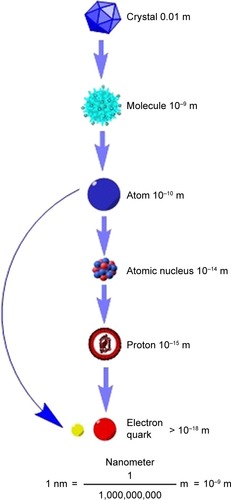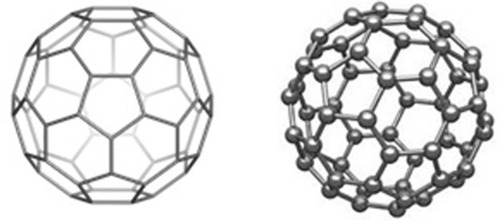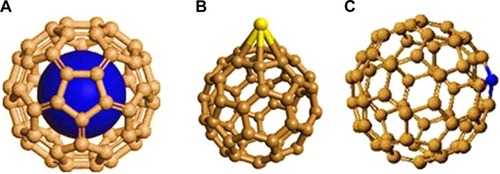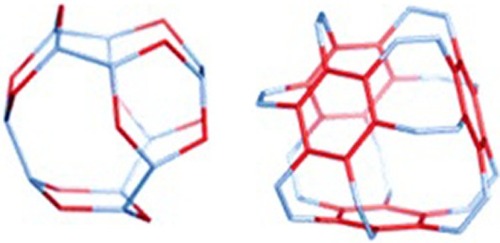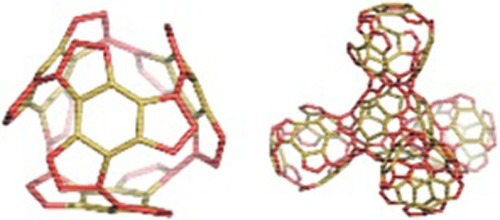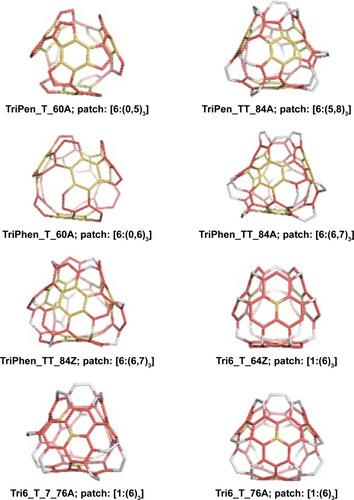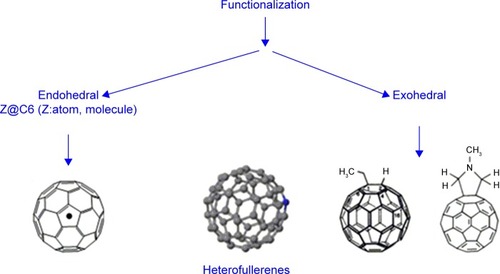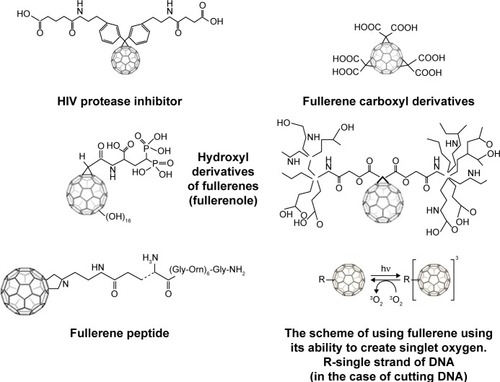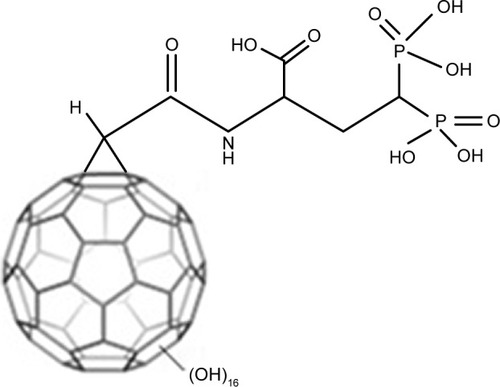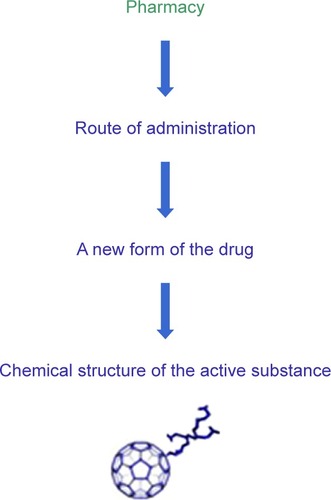Abstract
There are several reasons why nanotechnology is currently considered as the leader among the most intensively developing research trends. Nanomatter often exhibits new properties, other than those of the morphology of a continuous solid. Also, new phenomena appear at the nanoscale, which are unknown in the case of microcrystalline objects. For this reason, nanomaterials have already found numerous applications that are described in this review. However, among intensively developed various branches of nanotechnology, nanomedicine and pharmacology stand out particularly, which opens new possibilities for the development of these disciplines, gives great hope for the creation of new drugs in which toxicological properties are reduced to a minimum, reduces the doses of medicines, offers targeted treatment and increases diagnostic possibilities. Nanotechnology is the source of a great revolution in medicine. It gives great hope for better and faster treatment of many diseases and gives hope for a better tomorrow. However, the creation of new “nanodrugs” requires a special understanding of the properties of nanoparticles. This article is a review work which determines and describes the way of creating new nanodrugs from ab initio calculations by docking and molecular dynamic applications up to a new medicinal product, as a proposal for the personalized medicine, in the early future.
Introduction
In the last quarter of the century, fullerenes became one of the dominant discoveries in the field of physical chemistry. Fullerenes are a new allotropic form of carbon. Research on them has contributed to a huge number of scientific publications and their use is restricted by several hundred patents. In the year 1996, three explorers, Harold Kroto, Richard Smalley and Robert Curl, received the Nobel Prize in this field of chemistry, which confirmed the importance of this kind of science.Citation1 Not so long ago, it was thought that coal occurs in two allotropic forms that differ in their crystal structure, namely, diamond and graphite, but in 1985, the above-mentioned scientists revolutionized knowledge about carbon and discovered a new allotropic variety, a caged form of carbon.Citation2 The crystal structure of fullerenes is completely different from graphite and diamond, since it is made up of C60 and C70 carbon molecules. There are two fundamental differences between graphite, diamond and fullerenes. The first two mentioned varieties of carbon occur in atomic form, while fullerenes are its molecular form. In the crystalline networks of diamond or graphite, peripheral atoms are saturated with other elements, most often more reactive hydrogen; so, formally, carbon in these varieties does not occur in pure form. Fullerenes, on the other hand, are a variety of pure carbon. The discovery of fullerenes and the enormous development of research in this field have led to increased knowledge about carbon nanostructures. At the beginning of the 90s, carbon nanotubes (CNTs), carbon nanocrystallites with onion structure and carbon nanocapsules were discovered. Nanotechnology is an absolutely new quality in technology and, at the same time, it is something so different that it cannot be compared to anything else. It is an action in the world of small objects with sizes reaching individual molecules of chemical compounds. The smallest objects which man had dealt with were located on a micro-scale, which means that they were described in millionth of a meter. This was practically enough to deal with the anatomical description of the cells of living organisms and some of their structural parts. A limitation of the study of smaller structures was the resolution of optical microscopes. After the invention of the electron microscope in 1931, it became possible to distinguish two separate points even closer together. Nanotechnology can be defined as a science dealing with objects for which the smallest elementary particle does not exceed 100 nm even in one plane (). This size is, in fact, comparable with the size of macromolecules such as enzymes or receptors (about 5 nm) and is smaller than the human cell, whose size is estimated at 10,000–20,000 nm.Citation3–Citation5
This technology interferes with the structure of matter at the molecular level, and thanks to this, we can count on the rapid development of certain fields of science, particularly material engineering, as well as chemistry, electronics, optics, pharmacy, medicine and cosmetology. Thanks to nanostructures, many physicochemical properties of substances, for example, melting point and color, can be controlled.
Structure
Fullerenes are (besides graphite and diamond) the third allotropic form of carbon. This name covers the entire family of molecules with the general formula C2n (n.16), in which the surface of the solid is built of only carbon atoms, located only on its surface ().
Among the large fullerene family, fullerenes containing 60 or 70 carbon atoms are the most widespread () and, at the same time, the best-known ones.Citation3,Citation6,Citation7 Studies of carbon clusters by mass spectrometry show that the “carbon ball family” is almost infinitely large. The knowledge of higher fullerenes is quite limited due to their much lower availability. The most popular fullerene (), containing 60 carbon atoms (the Buckminster fullerene C60), has the shape of a truncated icosahedron, that is, it looks exactly like a football. C70, on the other hand, has an additional ring of carbon atoms and it is the best-known higher fullerene. Compared to C60, its molecule has a hexagonal ring band attached to the middle, which reduces the symmetry of the fullerene cage. C70 has an ovoidal structure and has physicochemical properties similar to C60.
These particles have many interesting qualities, and their electrochemical properties () are particularly interesting and intensely studied.Citation8–Citation20
Figure 4 Allotropic varieties of carbon.
Note: Data from Dubois et al.Citation21
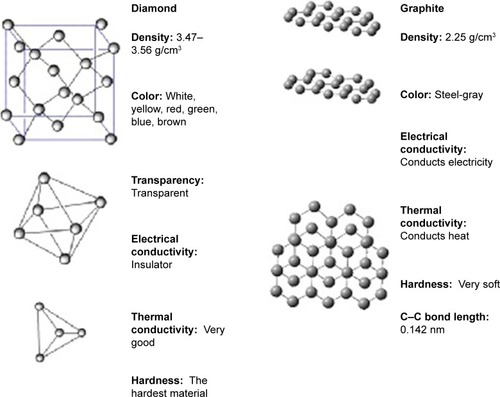
Due to its spatial structure, the fullerene molecule C60 enjoys the greatest attention from scientists and it is considered to be an “ideal” structure ( and ). The C60 fullerene molecule has the shape of a spheroid, or more precisely a truncated icosahedron, which has 60 vertices, each constituting one carbon atom (). According to the theoretical proof of L Euler,Citation224 a symmetrical solid with C20+2n vertices must be enclosed by 12 pentagons and n hexagons. The smallest carbon cluster that meets this rule is C60 and its particles have a diam eter slightly greater than 1 nm. Each of the C60 fullerene carbon atoms is surrounded by an identical environment; therefore, all atoms are equal and the molecule does not contain weak points of chemical interactions. Although the wrapping of the graphite layer in the carbon cage is accompanied by stresses, thanks to symmetry, they are distributed evenly across the molecule.Citation22 C60 molecules have a symmetrical structure and, thanks to that, they are extremely durable.Citation23
Fullerenes classification
The multi-atom carbon fullerenes are completely empty inside and have a sufficiently large inner diameter to accommodate even the largest atoms of chemical elements (), including radioactive elements and noble gas atoms (endohedral fullerenes).Citation24–Citation26 Exohedral fullerenes, on the other hand, are fullerenes to which foreign atoms are joined from the outside of the fullerene cage. Heterofullerenes are fullerenes in which the carbon atoms are replaced by other atoms ().
Figure 6 Examples of small and large fullerenes.
Note: Data from JonesCitation23 and Guo et al.Citation27

The results of research on the synthesis of endohedral fullerenes with uranium proved to be a surprise. The formation of a stable U @ C28 structure was proved, and also, model calculations showed that C28H4 fullerene having four external hydrogen atoms should be a very stable structure. Thus, the search for the smallest fullerene that can bind some chemical outside or inside the atoms of its cage seems to be an extremely important task.
The creation of new nanoobjects requires a special understanding of the properties of nanoparticles, and because the carbon allotropy has a dominant role in nanodomain, both for theoretical reasons and their further applications, zero-, one-, two- and three-dimensional carbon-based structures were studied, such as fullerenes, nanotubes, graphene, spongy carbon and hyper-diamonds. As nanostructured functional materials, inorganic compounds such as silicates, borates, selenides, sulfides and oxides have also found several applications. Action at the molecular level has led to the development of nanotechnology in many areas such as material engineering, chemistry, biology and cosmetic area, but in pharmacology and medicine, and quantum computing, it can be useful in providing the theoretical background for new syntheses and applications. Properties of fullerenes result mainly from their aromatic character.
Physicochemical properties of fullerenes
Fullerenes exhibit several similar general physicochemical properties. They do not dissolve well in typical organic solvents (much better in aromatic than in aliphatic ones), and the best solvents include benzene and its derivatives, toluene and carbon disulfide. Maximum solubility at 280 K does not increase with increasing temperature. The solution of C60 in toluene is purple and C70 is red. Fullerenes are easily solvated/combined with solvent molecules to form stable complexes. C60 molecules form a crystalline structure and their geometric structure corresponds to beveled regular icosahedron and has 12 pentagonal rings, 20 hexagonal rings and 30 double bonds located in six-membered rings. Fulleryte with a density of 1.65 g/cm3 has the distance between centers equal to 1,004 nm and it is an electrical insulator. Despite the initially expected chemical inactivity of C60 and its derivatives, it turned out that fullerenes can be functionalized. Based on the way of functionalization, it was distinguished into exo- and endohedral forms of fullerenes and heterofullerenes.
C60 and its homologues have interesting and often unique properties; hence, they show potential applications in many areas such as superconductivity, photo-optics, biochemistry, catalysis, material and fuel engineering. The physicochemical properties used in the areas of prospective application of fullerenes are illustrated in :
Figure 8 The physicochemical properties of fullerenes.
Note: Data from Kadish and Ruoff.Citation53
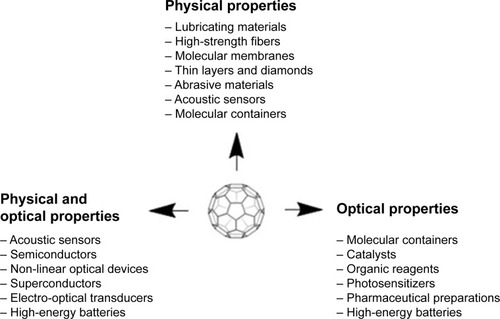
In the 90s, CNTs, carbon nanocrystallites with “onion” structure and carbon nanocapsules were discovered. Nanotubes are single-walled or multi-walled carbon tubes with a diameter of even <1 nm and lengths larger by many orders of magnitude with extremely interesting physicochemical properties.
The development of research in this field preceded by the discovery of fullerenes had resulted in tremendous increase in knowledge about the carbon nanostructure.
Chemical properties (aromaticity)
Fullerenes and other nanoparticles are aromatic structures. Aromaticity is used to describe the durability and reactivity of structures containing delocalized π electrons.Citation28–Citation33 However, the delocalization of π electrons alone does not justify the particular durability that aromatic compounds have. The π electron cloud must contain a certain number of electrons, fulfilling the Hückel rule. The cyclic (planar) π electron system with (4n+2) electrons is more stable than the system containing (4n) electrons. Aromaticity is a multidimensional concept. Due to the complexity of the phenomenon of aromaticity, one parameter is not enough to describe it. The statistical surveys conducted show that two or even three independent indices are necessary to describe the variability of the aromatic character, hence the diversity of indexes describing the aromaticity of compounds.
In the “energetic criterion”,Citation34–Citation37 the concept of energy criterion is based on resonance energy and aromatic stabilization energy. This concept results from Pauling’s theory of valence bonds. One of the effects of π electron delocalization is to increase the thermodynamic durability of molecules compared to similar structures in which such delocalization is not possible. However, in the case of nanoparticles, their stability and reactivity is related not only to the energy criterion, but also, above all, to their deformation.
In the “electronic criterion”,Citation34,Citation35,Citation38 the distribution of π electron can be represented by the numerical structures of the Kekulé values, allowing the construction of one numerical structure to superimpose the geometric structures of Kekulé. An example may be icosahedral C60 which has 12,500 such structures. The higher the Kekulé structure, the higher is the stability.
Schleyer proved that the aromatic compounds are those structures that exhibit high magnetic susceptibility, “magnetic criterium”.Citation39–Citation45 The basis of research is the chemical shift of protons in the nuclear magnetic resonance spectrum. The greatest influence on such chemical shifts has local diamagnetic currents, paramagnetic currents acting on further distances and annular electron currents. In case of fullerenes, aromaticity as assessed by magnetic criteria reflects reactivity and stability.
The “geometrical criterion” says that in aromatic compounds, the carbon–carbon bond lengths are the same, and single and double bonds cannot be distinguished.Citation34,Citation35,Citation46–Citation52 The most frequently used index of aromaticity based on this criterion is the Harmonic Oscillator Model of Aromaticity (HOMA) index. Originally defined for hydrocarbons, it was later extended to heteroatom-containing compounds. The “structural/geometric criterion” predicts for C60 bond length variation between [6,6]- and [5,6]-bonds. Based on experimental data, the [6,6]-bonds are shorter than [5,6]-bonds in neutral fullerenes.
As the carbon allotropy has a dominant role in the nano-field, both for theoretical reasons and for further application prospects, the following carbon structures were tested: fullerenes, nano-pipes, graphite, diamond and spongy blocks of CNTs, namely, from zero-, to three-dimensional structures. In this way, several articles and several chapters of books were created.
Circulenes
A circulene is a molecule that looks like a flowerCitation17 with a core and surrounding petals. The general formula is [n:(p1,p2)n/2], where n is the size of the core polygon and pi are the polygonal petals. For n>6, the molecule is saddle shaped, whereas for n<6, it has a bowl-shaped geometry.Citation54–Citation56 The second type of circulenes is useful in the synthesis of fullerenes,Citation57,Citation58 while the first type can be found in the spongy carbon.Citation59–Citation61
Two types of fullerenes, one with joined patches and the other one with disjoined patches, are shown in .
Figure 9 The [5:6Citation5] patch in fullerenes: joint patch in C140 (left) and disjoint patch in C240 (right).
![Figure 9 The [5:6Citation5] patch in fullerenes: joint patch in C140 (left) and disjoint patch in C240 (right).](/cms/asset/6a72586c-5e6a-4850-b101-a3a270efe046/dijn_a_172907_f0009_b.jpg)
In are shown coronene [6:66], isocoronene [6:(5,7)3] and sumanene [6:(5,6)3]Citation63 circulenes.
Figure 10 Circulenes with hexagonal core: coronene (left); isocoronene (middle) and sumanene (right).

The stability of the considered polycyclic compounds was estimated on the total energy per C atom and highest occupied molecular orbital(HOMO)-lowest occupied molecular orbital (LUMO) gap,Citation63 which can represent chemical hardness and is also an indicator of the molecular kinetic stability. The aromatic character of various flowers was estimated on three criteria: magnetic nuclear-independent chemical shifts (NICS)Citation62 (1 Å above and below the geometric center of gravity of the ring and in the middle of the aromatic ring), energetic (heats of formation) and geometric HOMA index ( and ).Citation63
Diamond D5
Diamond D5Citation8,Citation16,Citation64 is a hyperdiamond with pentagonal rings, built up on the frame of mtn structure, appearing in clathrate hydrates of type II. The C17 (centrohexaquinane) was proposedCitation64 as the seed of D5. However, the classical diamond is Diamond D6Citation66–Citation72 (), built of hexagonal rings with sp3 carbon atoms, and it is used in technology and jewelry because of its mechanical characteristics and esthetic appeal. Ultrasound cavitation,Citation73 chemical vapor deposition and high pressure–high temperature are applied to produce synthetic diamonds. A hexagonal network is called lonsdaleite (space group P63/mmc),Citation74 and several diamond-like networks have also been proposed.Citation65,Citation75,Citation76 Some multitori were proposed by Diudea and IlícCitation77 (). For example, the name of diamond D5 was given by DiudeaCitation8,Citation16,Citation64,Citation77,Citation78 for structures with pentagonal rings.Citation8,Citation16,Citation64,Citation77 As it was presented earlier, the seed of this diamond is C17 centrohexaquinane earlier studied by Gund and Gund,Citation79 Paquette and VazeuxCitation80 and more recently by Kuck.Citation81–Citation83 The hyperdiamond D5 belongs to the space group Fd-3mCitation84,Citation85 and is built up in the frame of mtn structure as a trinodal net. However, D5 belongs to the type II clathrate C34.Citation86 This family of clathrates is a Si34-analog, which was already synthesized. C34 is the repeating unit of the diamond D5 network and is formed by dimerization of two molecules of C17 (). An adamantine ada_20_158 (, left) can also condense to form the diamond D5 network (, right). The main unit of the hyper-diamond D5 can be C20. In a large enough network, the ratio C-sp3/C-total renders to 1. The net is called the diamond D5Citation8,Citation16,Citation64 because most of the rings in the molecule are pentagonal.
Figure 11 The repeating units, in crystallographic terms, of the diamond D5 and D6 networks.
Notes: (A) Diamond D6 and its repeating unit adamantane. (B) Two C17 units give a dimer C34; (C) the C17; (D) adamantane; (E) C17_hexaquinane triooxo-derivatives: Paquette P1 and Diudea, D1 and D2.
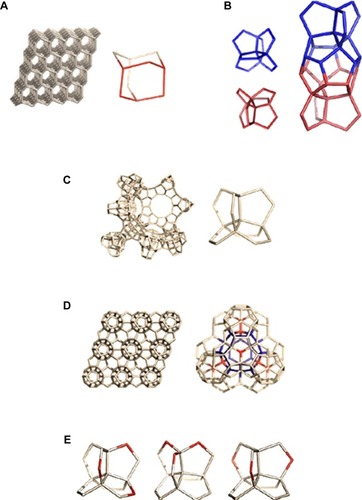
During the study of diamond D5, four carbon structures were investigated based on C17 skeleton, built of carbon atoms or from carbon and oxygen atoms. The research was carried out using the molecular dynamics (Amber) and the ab initio methods at discrete Fourier transform (DFT) level. The structural stability was assessed on the basis of root-mean-square deviation (RMSD) and the total potential and kinetic energy obtained after molecular dynamics simulations. The four hypothetical seeds of D5 were used for structural and energy stability studies of the all-carbon structure C17 and the ones built from carbon and oxygen atoms (trioxa derivatives of C17), as shown in . The isomer P1 was synthesized by Paquette and VazeuxCitation80 (), while D1 and D2 were proposed by DiudeaCitation8 (). The last structures would be used in dimerization to C34, with the repeating unitCitation86 called D5.
The all-carbon seed C17 was the most resistant to changes in temperature during all molecular dynamics, while D2 isomer was the most sensitive to changes in temperature among the four studied structures. The structural stabilities of P1 and D1 isomers were similar and only slightly more sensitive to temperature as compared with the all-carbon C17 in molecular dynamic (MD). The structure of D1 was the most stable also after optimization at the DFT level of theory.
In the future, the results can have a practical aspect and can be used for dimerization reactions to C34 and condensation to adamantane-like structures, finally leading to diamond D5.
Polybenzenes
The structural stability (Hartree–Fock [HF] level, DFT) with respect to C60 as well as to diamonds (D5 and D6) has also been estimated for polybenzenes.Citation15 O’Keeffe et alCitation87 projected two kind of structures: 6.8Citation2 D (polybenzene, ), belonging to the Pn3m space group with the topology of diamond, and 6.82P, belonging to the Im3m space group, similar to P-type surface. Both described structures show higher stability compared to C60. The 6.8Citation88 D that can stay as an insulator, 6.8Citation88 P that is metallic, as well as zeolites and spongy carbon represent schwarzite structures.Citation88–Citation91
Figure 12 Benzene rings in the D-surface; BTA_48=6.82 D (left) BTA_48 unit (middle) and its diamondoid BTA_fcc-network (in a [K,K,K]-domain, k=3, right).
![Figure 12 Benzene rings in the D-surface; BTA_48=6.82 D (left) BTA_48 unit (middle) and its diamondoid BTA_fcc-network (in a [K,K,K]-domain, k=3, right).](/cms/asset/41bb1c4f-4e28-43f5-b40c-c76db31dbeef/dijn_a_172907_f0012_c.jpg)
Polybenzenes can spherically evolve or show linear periodicity ( and ). In this way, two structures are created, namely, BTA_48 and BCZ_48, respectively ( and , left), colloquially called an armchair (BTA_48) and a saddle (BCZ_48). Tetrahedral unit BTA_48 can be possibly identified either by octagons R(8) or by dodecagons R(12). Identification by R(8) leads to 6.8Citation2 fcc-net (, right), with the topology of D6-diamond.Citation92,Citation93
Figure 13 Benzene rings in the P-surface; BCZ_48=6.8Citation2 P (left), its networks in a cubic (K,K,K)-domain, k=3 (middle) and the corner view of this network (right).

There are oligomers of BTA_48 such as BTA2ecl_90 (, left) and BTACy5_210 (, middle) and the multitorus BTA20_780 (, right), where the second structure can be built of the first and the third structure can be built of the second by self-arranges, respectively.
Figure 14 Oligomers of BTA_48: BTA2ecl_90 (left) and BTACy5_210 (middle) and the multitorus BTA20_780 (right).

The 3-periodic net BTZ24anti_333 with {6.9Citation2}; 3-c net “uta” belongs to the Fd-3m space group (). A quasi-spherical structure of icosahedral symmetry can be created by 12 units of BTZ20 in self-arrangement. The 1-periodic networks can be formed by the units BTA20 and BTZ20 ().
The results showed a significant stability of these structures, which gave a further perspective on their synthesis in the laboratory. Therefore, the Raman spectra and the infrared spectra were tested.
After calculations, the most stable were BTA_48 and BCA_96, both structures with values of Etot/atom(au) equal to 38.156 au. On the other hand, the least stable structure was BCZ_72 (Etot/atom(au) equal to 38. 056 au). However, the BCZ_48 structure showed the highest value of geometry index of aromaticity HOMA (0.989).
As suggested O’Keeffe et al,Citation87 the stability of polybenzene based on HOMO–LUMO HL gap and values of Etot/C was over that of the reference C60 fullerene and resembled the stability of diamond networks.
The values of Etot/atom, HOMA and HOMO–LUMO gap calculated after optimizations at HF (HF/6–31G**) and DFT (B3LYP/6–311+ G**) levels of theory revealed that the stability of dendrimers decreased monotonically with the increasing number of atoms, and also, the dendritic dimer was less stable than the diadimer. Compared to the reference C60, all tested polybenzenes, that is, dendritic dimer and diadimer were very stable.
During the study, a structure construction of the network units of polybenzene, described by O’Keeffe et al,Citation87 was proposed. Their stability, relative to fullerene C60 and diamonds D5 and D6 was estimated at the HF level of theory. The calculations carried out confirmed their stability. The practical aspect of computational work is clearly visible here, which is obviously worth emphasizing.
Polybenzenes multitori
MultitoriCitation9,Citation10,Citation14 are complex structures consisting of more than one single torus.Citation94–Citation97 They include negatively curved substructures,Citation98–Citation100 termed schwarzites.Citation98–Citation102 Multitori appear in natural zeolites and in spongy carbon, formed by self-assembly of repeating units. Multitori can show a linear periodicity or they can develop spherically, creating systems of different complexity.Citation103 The map operationsCitation103–Citation109 were used for design of Multitori with CVNETCitation110 software and Nano Studio.Citation111 Multitori, similar to rods, show a linear periodicity or can spherically evolve, and in this way were formed the polybenzenes multitori BTZ and BTA. The multitori BTA (“armchair”) were compared to the (“zig-zag”) BTZ ().
Figure 16 Top row: BTZ_24 designed from S2(T)_28=C28. Bottom row: BTA_48 formed by spanning the Le(P4(T))_48 cage.
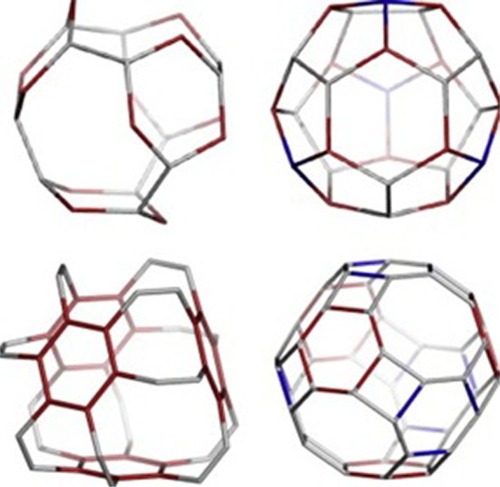
The calculations at the HF level of theory (HF/6–31G**) were performed in the gas phase using Gaussian 09Citation112 program, and based on HOMO–LUMO gap and the total energy/carbon atom, the energy and structural stability were estimated. Also, using JSChem program,Citation113 the strain energy values were estimated. As usual, the C60 structure was taken as the reference. The analysis of the obtained results showed that BTZ multitori were as stable as C60 fullerene. Even so, BTA are more energetically stable compared with BTZ, which makes them more likely to exist in spongy coal or zeolite structures. BTZ multitori can be eventually synthesized in the laboratory.
Nanotube junctions
As described above, modeling of fullerenes and nanotube junctionsCitation11,Citation12 can be combined by using some mapping operations. In this way, high-generation dendrimers can be constructed. Again, the hypothetical nanotube junctions were constructed using CVNETCitation110 and Nano StudioCitation111 software programs (TOPO GROUP CLUJ-international scientific group created by prof. M.V. Diudea focus researchers from many countries, Babes-Bolyai University, Faculty of Chemistry and Chemical Engineering, Cluj-Napoca, Romania). Eight tetrapodal units were designed, where the energies were estimated at the HF level. Their stabilities are discussed in the scope of HOMO–LUMO space, energy of bonds and the HOMO aromaticity index and total energy.Citation34,Citation35,Citation46–Citation52 The calculations were carried out by using G09Citation112 at the HF (HF/6–31G**) level of theory in gas phase. The open-end hydrogenated structures were used for calculations. As a reference structure, C60 was considered. During the synthesis of nanotube fullerenes, single- and multiwalled nanotubes, onion-fullerenes and others can appear. Experimentally, fullerenes can be spanned. In this way are built open cages. The open faces can be prolonged by nanotubes of various chirality and tessellation (most probably, a hexagonal one). Such spanned fullerenes (prolonged or not) are called nanotube junctions. They can be tetra-, octa- and icosahedral, when symmetry is taken into account.
The junctions (tetrapodal and tetrahedral) are very interesting. They exhibit similarity with the sp3 hybridized tetrahedral carbon atom. The valences are now nanotubes, while the atom is an opened cage embedded on the surface of genus 2.Citation114,Citation115 As there is a single C atom, a tetrapodal junction can be used to build various nanostructures such as dendrimers and multitori multi torus (MT).
The connections the points of connectivity two of five units named TriPen_T_60A 60A and the dendrimer (at the first generation) with the patch of this unit called “tripentylene”, [6:(0,5)Citation3] (). The unit TriPhen_T_60A can self-arrange, using map operations Le(Op(Ca(T))), to a pentagonal multitorus MT comprising five such units ().
Figure 18 Top row: TriPhen_T_60A (left) and a pentagonal hyper-ring (right). Bottom row: Multitorus MT(Le(Op(Ca(T)))); [Op(Ca(3,2)C(I))] (left) and its core (right).
![Figure 18 Top row: TriPhen_T_60A (left) and a pentagonal hyper-ring (right). Bottom row: Multitorus MT(Le(Op(Ca(T)))); [Op(Ca(3,2)C(I))] (left) and its core (right).](/cms/asset/d0292e99-5d26-458c-9425-1c262ead582f/dijn_a_172907_f0018_c.jpg)
Next, using the map operations, from 12 pentagonal MT, the MT20Citation116–Citation118 (a supra-structure) can be created ().
After optimization of the study structures, Etot/C, HOMO– LUMO HL gap and the total energy of course were calculated ().
Table 1 Tetrapodal nanotube junctions and their energy propertiesTable Footnotea
The obtained values confirmed the possibility of using various nanotube junctions in further experimental work by welding the randomly superposed nanotubes. In comparison to C60, the value of EHF/C is favorable for tetrapodal junction. According to the Haddon’s theory,Citation119–Citation123 again, the HOMO– LUMO gaps are in favor of these open structures. Based on this part of the study, it can be concluded that the tetrapodal junctions can be used for the synthesis of new nanostructures in the laboratory.
In the next step, the CNT junctions can self-assemble into more complex structures, such as diamondoids and/or multitori of high genera.
The units were designed by using symmetry in embedding the triple hexagon patches (, left column) or starting from the objects Op2a(S2(M)); M=Tetrahedron T or Cube C with deletion of one atom from each heptagonal face of the transformed map M (, right column). An “eclipsed” dimer, the unit T_3HexZ_52 forms, which can self-arrange to a hyper-pentagon, and the joining of 12 such hyperfaces leads to a multitorus T_3HexZ20_1040 () of icosahedral symmetry.
Figure 20 T_3HexZ_52 (top, left), T_3HextwZ_40 (top, right), C_3HexZ_104 (bottom, left) and C_3HextwZ_80 (bottom, right).

Figure 21 Multitorus T_3HexZ20_1040; g=21 (left) built up by T_3HexZ_52 and its substructures: T_3HexZ10_520; g=11 (middle) and a hyper-pentagon T_3Hex5_260; g=6 (right).

An “intercalated” dimer is built from the unit T_3HextwZ_40, leading to a hyper-hexagon, forming diamondoids at the end ().
Figure 22 Diamondoids built up by T_3HextwZ_40: Ada_400; g=11 (left), Dia_560; g=15 (middle) and the network T_3HextwZ_(2,2,2)_1760; g=45 (right).

The unit C_3HexZ_104 can build a multitorus as an infinite periodic lattice with k-the repeating unit embedded in the P-surface ().
Figure 23 C_3HexZ_104, g=3 (left), its P-type-crystal network C_3HexZ_(3,3,3)_2808 (middle) and the same array in the corner view (right).

Examples are four units open to be inserted in exactly 4×2 simple tori and one more torus that joins all the above four units ().
Figure 24 Multitorus C_3HexZ4_1184; e=1776; f6=496; f7=64; f8=16; f=576; by Euler formula, g=_(1184_1776+576)_2)/2=9; by theorem 2, g=2_4+1 (in black/red)=9.
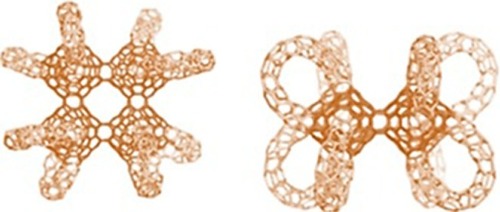
The Euler’s theorem was applied to calculate the genus in a differently tessellated network ().
Figure 25 Sum_CZ_192, g=3 (left), its P-type network Sum_CZ_(3,3,3)_5184 (middle) and its corner view (right).

The unit C_3HextwZ_80 can form a multitorus C_3HextwZ15_1200 (). The six units of octahedron are joined by a central unit according to Cartesian coordinate directions. The eight units of the cube are connected to the centers of their faces by the diagonal directions (, middle). In this way, as in the diamond, the octahedron fits the face-centered cube positions. Thus, the cube accommodates the vertices of its dual (the octahedron) in the center of its faces and one unit in the cube/octahedron center. Among any four units there is a hollow space; the structure can evolve periodically in a single direction (, right).
Figure 26 C_3HextwZ15_1200, g=31, m=1 (left); its reduced graph, v=15, e=30 (middle) and a linear periodic array C_3HextwZ25_2000, g=52, m=2 (right).

It can be concluded that stability of the investigated junctions is comparable with the reference fullerene. The closest values to the reference structure show “twisted” junctions (). As expected for structures with larger “open” faces, the strain is lower for the octahedral junctions. Because the twisted structures are more anti-aromatic in comparison to the non-twisted ones, the geometric index of aromaticity HOMA is not relevant.Citation121
Table 2 Structural and energetic properties for two types of triple hexagon patched nanotube junctionsTable Footnotea
The vibrational spectra of study junctions were simulated, which identified the differences between twisted and non-twisted structures and between the two different embeddings (tetrahedron and cube).
Based on this part of research, it can be concluded that various nanotube junctions could appear in real experiments by welding, under an electron beam, of the randomly superimposed nanotubes.
Spongy nanostructures
Spongy structuresCitation18,Citation84 are high-genera and large nanostructures with characteristic holes on their surface. Some new structures, spongy polyhedral, were proposed for research. They can evolve with 1-periodicity or radially, to provide multi-shell cages.
Because of the large number of atoms, that is, >1,500, the density functional-based tight binding (DFTB) methodCitation124,Citation125 was used for computing of these structures. This method was combined with the self-consistent charge (SCC) technique and resulted in SCC–DFTB method.Citation126 In this way, the results obtained were comparable with some higher-level theoretical methods.Citation127–Citation129 The SCC–DFTB geometry optimizations were performed using the DFTB+ program.Citation125 DFTB is useful in the case of large nanoparticles. For this reason, it has certain drawbacks, such as underestimation of the gap values in the case of sp2 carbon-only structures and overestimation of the gap values for the hydrogenated ones. Gaussian 09Citation112 was used in the case of some structures with level of calculations HF and DFT and 6–31 g (d,p) basis set. The small radius of C20 (ie, large pyramidalization angle of sp2-hybridized carbon atoms) causes an extremely high reactivity/instability of the dodecahedron-based structures, such as carbon-only structures, but they become more stable by hydrogenation.Citation124 For reference, the fully hydrogenated C60H60 was chosen here. One can see that full hydrogenation of the dodecahedron as C20H20causes structural stabilization (). The values for the included structures show, however, a lower stability; the spongy cage Do(Do20)_250H100 () is more stable than the corresponding filled structure Do@ Do(Do20)_270H80. Passivation by full hydrogenation, resulting in a far deeper gap, is important in the case of structures presented in . One can see that the filled structures () have values of HOMO–LUMO gap lower than the spongy ones, meaning a larger kinetic instability. Looking at the C60 dimers analogous to the hyperdimers on 750 and 810 atoms (figure in and entries 5 and 6), the same ordering can be found in for the carbon-only dimers: Gap (C60P2J5_115) > Gap(C60P2J6_114); this could be a result of the fact that joining by pentagonal faces (J5) results in more hexagonal faces, involved in double-bond conjugations, thus stabilizing the whole structure. Conversely, the passivation by hydrogenation is more effective in the case of J6-dimer, which is more reactive than the carbon-only molecule. Three series of calculations were made on DFTB, HF and DFT levels of theory to see if the ordering of stability is influenced or not by the used approach. We can see that because the calculations are made in vacuum (no solvation process involved), the ordering is preserved in these three approaches.
Compared to fullerene C60, the structures built up by C60&C24&C10 show the highest stability (). The values of HOMO–LUMO gap and energy/atoms (in DFTB) in the case of cages with 300 and 900 atoms are higher than in case of C60. These multi-cages contain the C60 fullerene non-coalesced with itself but separated by smaller cages C24 and C10. The last structure in also represents an aggregation of C60, with the units sharing a pentagon, while the interspaces have the topology of twin-truncated tetrahedral TT. It is relatively less stable as carbon-only structure, compared with the non-coalesced C60 structures. Hydrogenation of rod-like structures based on C60 & C12 aggregation () could provide stable, useful materials ().
Table 3 DFTB data for DO/C20-based hydrogenated spongy structures (figure in the last row in the table); reference structure C60H60
Table 4 DFTB data for the spongy C60-based structures (figures in the last row in the table)
Table 5 Energy data for the C60 dimers (figure in the last row in the table)
Table 6 DFTB data for spongy C60-based structures, as carbon-only cages (figures in the last row in the table)
Table 7 DFTB data for linearly aggregated C60 & C12 cages (figure in the last row in the table)
Fullerenes in medicine: how nanotechnology extends diagnostic and therapeutic possibilities?
There is a reasonable belief that the most important future applications of fullerenes lie in the field of medicine. After all, carbon is the basis of all living organisms and the fullerene discovery can certainly be compared to the discovery of benzene, whose derivatives account for 40% of all drugs, even the most popular aspirin. The C60 molecule can bind to any functional group. At the same time, it is indifferent, nontoxic and so small that it easily comes into contact with cells, proteins and viruses. In addition, its interior can also be filled with active substances. During working on small objects, we observe a very important feature, mainly increasing the surface to volume ratio, which makes the molecules chemically more reactive. Only this single feature makes it possible to drastically reduce the dose of the drug without impairing its therapeutic effect. Nanotechnology has allowed the development of new materials (called nanomaterials) with a number of properties that are desirable, such as antibacterial effect, magnetic excitation, increased conductivity or electrical resistance, increased resistance to corrosion and abrasion and increase in plasticity. That is why, they can be used in medicine.
The main problems regarding the use of fullerenes in medical chemistry were their insolubility in polar solvents, as well as formation of aggregates in aqueous solvents. However, these problems have been solved through a series of chemical modifications of fullerene molecules. Therefore, the so-called exo- and endohedral functionalization is carried out ().
The essence of exohedral chemistry is the chemical reactions of attachment occurring “outside” the fullerene molecules, in which the structure of the carbon cage remains unchanged (). The prospects of fullerenes’ connections are huge, as there are an astronomical number of isomers. In “Chemical Abstracts” – the basic source of citations of chemical literature in this field in the world – there are already >5,000 known fullerene derivatives. Unlike other organic, aliphatic and aromatic compounds, fullerenes do not contain hydrogen atoms or other functional groups, so they cannot undergo substitution reactions (except heterofullerens). Substitution reactions occur only with “functionalized” fullerenes, that is, when they have been attached to specific groups of atoms.
Exohedral fullerenes
The exohedral reactions of fullerenes are mainly based on the attachment of radicals or functional groups to carbon atoms by saturating the double bond. Exohedral chemistry of fullerenes is extremely rich and covers all basic areas of organic functionalization (). The research concerns mainly C60 and, to a lesser extent, C70. Fullerenes, C60 and C70, can take part in many different reactions, including the most typical – reduction and oxidation. Reduction – joining reactive atoms, most often hydrogen atoms, to the outside of the carbon cage – is carried out by various techniques, and currently, the most hydrogenated fullerene is C60H36. Also, fullerenes can be oxidized, with the C60 molecule being less resistant to pure oxygen than graphite at a temperature of about 500 K. Mild oxidation leads to the formation of epoxide compounds of the C60On type, where n may vary from 1 to 4 and carbonyl groups appear in the molecule without disturbing the structure of the molecule. An interesting group of derivatives are fulleroles, substituted with hydroxyl groups, which are soluble in water. C60Xn halogen derivatives have also been synthesized, where X is fluorine, bromine or chlorine and n can reach 60. Metallofullerenes are complex compounds of fullerenes with metals, in which the metals are elements from the platinum group and they have interesting catalytic properties ().
Endohedral fullerenes
From the beginning, the fullerene explorers had the idea that an empty “cage” of fullerene could be filled with something (). The diameter of C60 is 0.7 nm, so the interior of the molecule can be a “container” for other atoms of any size or can be a reactionary environment of endohedral chemistry, “intraframe” chemistry. The internal atom is insulated from the environment and, at the same time, the exchange of electrical charge. This results in interesting properties, for example, pure C60 is an electrical insulator and after taking over the metal charge, it can become a conductor. The fullerenes having an alkali metal atom its inside show superconductors properties and they are not sensitive to contact with air.
Heterofullerenes
Heterofullerenes are fullerenes in which a partial substitution of the carbon atom (s) in the C60 cage structure takes place by atoms of other elements, most commonly boron and nitrogen atoms. However, it has not been possible to obtain macroscopic quantities of such heterofullerenes to enable detailed examination and verification of their interesting properties ().
Cyclodextrin
The main problems concerning the use of fullerenes in medical chemistry are their formation of aggregates and insolubility and the formation of aggregates in aqueous solvents (polar solvents). However, these problems have been solved by a series of chemical modifications of fullerene molecules. Fullerenes can be closed in cyclodextrins, which mask the carbon sphere, thereby increasing the solubility of such derivatives in polar solvents. Due to the size of C60, the most common β-cyclodextrin cannot be used directly (). Hence, for the carbon masking of the sphere, dextrins of larger sizes are used, which form C60 complexes in a 2:1 ratio.Citation130 To create the possibility of using s-cyclodextrin to form a complex with the C60 molecule, fullerene was converted to a biphenyl derivative ().Citation131
Fullerene derivatives were also obtained by adding different hydrophilic groups to C60. The more such groups the fullerene molecule has, the greater its hydrophilicity. An example of such derivatives is the fullerene dendrimeric derivatives. The dendrimeric C60 derivative, having specifically carboxylic groups (), shows a high degree of solubility in water.Citation132 Cycloaddition processes are a large group of fullerene functionalizations (fullerene cycloadducts), which create the possibility of synthesis of a wide range of new compounds, for example, the preparation of macromolecular fullereno-dendrite is based on the addition of phenolic groups in the first stage, to which the dendritic macromolecule is then attached.
Figure 29 Structure of dendrimers.
Note: Data from Brettreich and Hirsch.Citation132

All modifications of fullerenes, by the attachment of different functional groups or entire molecules of chemical compounds, cause an increase in the hydrophilicity of derivatives and also contribute to the preparation of new compounds which exhibit biological and pharmacological activity. The properties of the new derivatives are slightly altered, but they still exhibit the characteristic physical and chemical properties of fullerenes.
Fullerenes can act as antioxidants, protect nerve cells, prevent cell apoptosis, act as enzyme inhibitors, have antibacterial and antiviral effects, and it is also planned to use fullerenes for the treatment of osteoporosis. Above all, they have already found quite a significant place in cancer diagnostics since nanostructures represent the future in anticancer treatment, and have also found application in cosmetology.
Dendrimers and fullerene derivatives
In the course of neurodegenerative diseases such as Lou Gehrig’s, Parkinson’s or Alzheimer’s, overproduction of ROS occurs. ROS are natural products of metabolism, but sometimes their concentration may increase rapidly leading to a phenomenon called oxidative stress. Too much ROS cause damage or death of the neuronal cell due to their oxidizing action. In such cases, it is beneficial to introduce a radical-scavenging agent that, although does not eliminate, significantly decreases neuronal mortality. Such antioxidant factors may be fullerene hydroxyl derivatives, fullerenols, which are excellent and are able to neutralize oxygen radicals. Fullerenols also reduce the toxicity of free radicals in the nervous tissue.Citation133 In contrast, other fullerene derivatives, carboxylefullerenes (), show effective counteracting action against the degradation of neuronal cells associated with amyotrophic lateral sclerosis.Citation134 Fullerenes can also prevent self-destruction, namely, apoptosis. It is a biochemical process of cells in which transforming growth factor-β plays an important role. During this process, ROS induction occurs and the only way to stop or at least reduce the scale of cell destruction is the use of antioxidants. Such properties are shown by fullerene carboxyl derivatives. Nanostructures may prevent apoptosis in some cells by neutralizing the ROS induced by transforming growth factor-β.Citation135
Numerous studies have been carried out on the nucleotide chain cleavage process in the presence of fullerene derivatives. This phenomenon occurs only in the presence of light and has been tested in bacterial cells and plasmids.Citation136 It is believed that one of the steps of the oligonucleotide chain cleavage mechanism is the photon excitation of fullerene, followed by the transformation of molecular oxygen into the induced singlet state 3C2. Then, fullerene returns to the basal state and, at the same time, the interaction of reactive 3C2 with the oligonucleotide occurs.Citation137 The proposed mechanism is shown in . This process can also be used in photochemotherapyCitation137 and, in particular, in the treatment of skin cancer.
Figure 31 The scheme of fullerene using its ability to create singlet oxygen.
Notes: In the figure, symbol R means single strand of DNA (in the case of DNA cleavage). First, 3C60 (100% efficiency) is created as a result of photoexcitation. Next, with the participation of excited fullerene and molecular oxygen, singlet oxygen 3C2 is generated, while the excited fullerene returns to the ground state. As a result, the DNA strand may be cut, thanks to the action of 3C2.
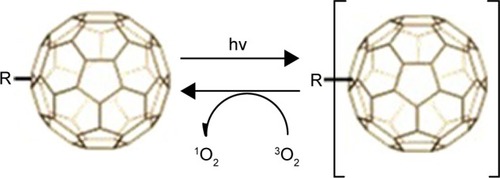
Some fullerene derivatives () may be inhibitors of enzymes such as serine proteases and cysteine proteases.Citation136 Fullerenes of S-glutathione transferase,Citation138 cytochrome P450 monooxygenase and mitochondrial ATPase were also found.Citation139 Electrophilicity and hydrophobicity with high reduction potential are the key elements of fullerenes’ activity toward enzymes. It is also expected that among fullerenes, effective anti-AIDS drugs will be found. The C60 derivative, which is an HIV protease inhibitor, has already been synthesized (). The molecule fits the active viral protease center and strongly interacts with the van der Waals forces.Citation140 Modifications of fullerene derivatives are still underway, aimed at a stronger interaction with HIV protease inhibitor and the most effective blocking of the enzyme.
The lipophilicity of the carbon sphere allows the incorporation of C60 into biological membranes, causing them to destabilize, which enables them to be used as antimicrobial agentsCitation141 against Bacillus subtilis, Mycobacterium avium, Candida albicans and Escherichia coli.Citation142,Citation143 The fullerene salts proved to be very effective. Attention should also be paid to fullerenopeptides.Citation144 The peptide derivative of fullerene () shows lipophilic properties with hydrophilicity and the ability to undergo electrostatic interactions, which is derived from the peptide part, makes them exhibit antibacterial properties. E. coli and Staphylococcus aureus bacteria were tested, which showed sensitivity to this derivative. An analogous peptide lacking the fullerene part () showed no activity against these bacteria.Citation145 In addition, fullerenopeptides may have different effects depending on the type of bacteria – acting more strongly on Gram-positive bacteria and less strongly on Gram-negative bacteria.Citation146
It is also hoped that fullerenes can be used to treat osteoporosis. Currently, in the treatment of this disease, diphosphate compounds and the F− anion are used. However, diphosphate drugs are not effectively absorbed from the gastrointestinal esophagus, and also, F− administered in the form of NaF is highly toxic.Citation147–Citation149 Diphosphate fullerene C60(OH)16AMBP () shows the ability to reduce hydroxyapatite mineralization.Citation150 Similar studies regarding compound C60(OH) indicated high affinity for hydroxyapatite. These results give hope for the use of these nanostructures in targeted therapy for this disease.
From a certain date, fullerenes have also been used as safe and effective contrast agents, iohexal and iopamidol. Only 2%–8% of the studied population exhibits allergic reaction after the contrast is administered. Therefore, it was looked for measures with longer duration of action, what could extend the observation time of the patient, and would be nontoxic for each patient. Because a fullerene cage is empty inside, it is possible to use fullerenes also in this field of medicine. A lot of isotopes have been placed in the middle of the carbon sphere, resulting in endohedral metallofullerenes.Citation151 Such molecules are characterized by high stability and lack of biotransformation, which prevents the release of toxic isotopes during therapy. Attempts have been made to use endohedral metallofullerene 166Ho@C82(OH)x as a contrast agent. This compound persisted in the blood over 1 hour, and after that it was almost completely removed from the body and showed no toxicity in vivo.Citation152,Citation153
There are also studies on the use of endohedral metallofullerene in MRI. Fullerenes can also be used as carriers of genes, proteins or medicinal substances.Citation154 It has been shown that the tetraaminofullerenic derivative can transport plasmid DNA.Citation155 Another fullerene derivative, C60(CO2H)2, has the ability to penetrate cell membranes and connect specifically to cell organelles.Citation156 In the future, fullerenes may be used as drug carriers, in particular, highly polar molecules attached to the fullerene sphere, such as C60-oligo DNA. Fullerene drug carriers can penetrate the cell membranes by transporting the drug to selected tissues.Citation157
Extremely interesting chemical properties and specific construction of fullerenes give many prospective opportunities to use these carbon balls.
Nanoparticles used in medicine and pharmacy
Based on the field of usage of nanoparticles, they could be divided into silver, gold, copper, magnetic and core–shell nanoparticles, quantum dots, fullerenes and CNTs. However, in medicine and pharmacy, the magnetic nanoparticles (MNPs) such as fullerenes and CNTs are mostly used.
Magnetic nanoparticles
MNPs are built of an inorganic core, for example, cobalt, nickel or iron oxide, with a coating that is compatible with the tissues into which it is inserted.Citation158 Magnetic properties of nanoparticles depend on the presence and modification of surface ligands, size of the core and, first of all, on the composition. The MNPs show the property of superpara-magnetism and are used in clinical diagnostic techniques. The introduction of MNPs into the examined tissue results in the disturbance of their local magnetic field, causing a reduction of relaxation time. This phenomenon is used in MRI.Citation159 The use of MNPs significantly improves the distinction between cancerous and healthy tissues. In addition to imaging tumor tissues, MNPs are used to observe the cardiovascular system, mainly in the detection of atherosclerotic plaques and other diseases of the cardiovascular system.Citation160,Citation161 MNPs can be additionally combined with organic and fluorescent dyes, for example, rhodamine or fluorescein isothiocyanate, which allows to determine the extent of resection of tumor tissue in an intraoperative study. Another application of MNPs is the supply of pharmaceuticals to specific pathological tissues by using the affinity of the surface ligands used, magnetic attraction and by manipulating the external magnetic field.Citation159
Biocompatibility, lack of toxicity and high accumulation in cancerous tumors enable magnetic nanosized magnetic particles (NCz) also to be used in the so-called “intracellular” hyperthermia. This therapy involves the use of MNPs and a variable magnetic field to produce a significant amount of heat in cancer cells. Depending on the temperature produced and the heating time, the death of cancer cells or their sensitivity to radiotherapy or chemotherapy is directly observed.Citation162
Because nanotechnology is a fast-growing multidisciplinary field of science, it has also found application in pharmacy (). It have been conducted studies about the route of dministration new forms of drugs or studies about the active substance of the chemical structure, what could lead to a reduce the toxicity of drug.
This technique, among others, is an innovative biodistribution method, for example, in studies on drug molecules delivered for a specific biological purpose. In recent years, interest in modern methods of drug delivery using nanostructures has increased, so you can count on a better ability to achieve a specific place of action of drugs (–). New excipients with potential application in drug technology have been developed, from which carriers of active substances, including proteins and genes, are constructed. The expected effect of the introduction of nanotechnology in medicine and pharmacy in this area is to increase the effectiveness of medicines and decrease the side effects of excipients (–). Currently, nanoparticles are mainly used as drug carriers and substances with antibacterial and virucidal properties. They also play a large role in diagnostics, where they are used in immunohistochemistry, genetic research and in the detection of pathogens and tumors. They increase the speed, accuracy and sensitivity of biological tests with small sample volumes. Despite many advantages and applications not only in the field of medicine, but also in environmental protection and in various technological branches, it is necessary to conduct the cytotoxicity tests of the nanoparticles and nanomaterials.
Table 8 Nanoparticles as carriers of anticancer drugs
Table 9 The use of nanoparticles in the diagnostic imaging of tumors
Table 10 The use of nanoparticles in the diagnostic imaging of tumors
Fullerenes and CNTs
Fullerenes are nanostructures with a shape similar to the sphere composed of conjugated rings consisting of five or six carbon atoms. The most popular ones are 60-atom nanostructures with the shape of a truncated icosahedron. CNTs assume the shape of an empty cylinder made of coiled graphene (). They can create structures with a length of a few centimeters and a diameter of a few nanometers. Due to the number of layers building the wall of the nanotube, they are divided into single-wall nanotubes and polyhedral nanotubes ( and ).
Figure 35 CNTs.Citation199–Citation205
Abbreviations: CNTs, carbon nanotubes; DWCNT, double-walled carbon nanotube; MWCNT, polyhedral carbon nanotube; SWCNT, single-walled carbon nanotube.
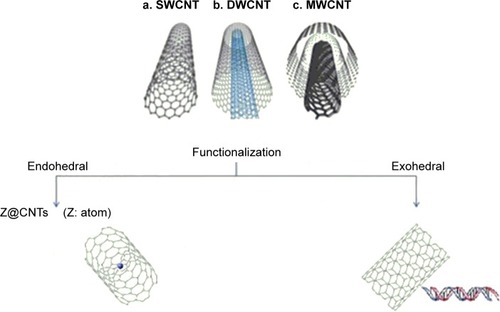
Figure 36 Equilibrated structure of the SWNT–PSE–GOX complex.Citation199
Note: Data from Mackay.Citation199
Abbreviation: SWNT, single-walled nanotube.
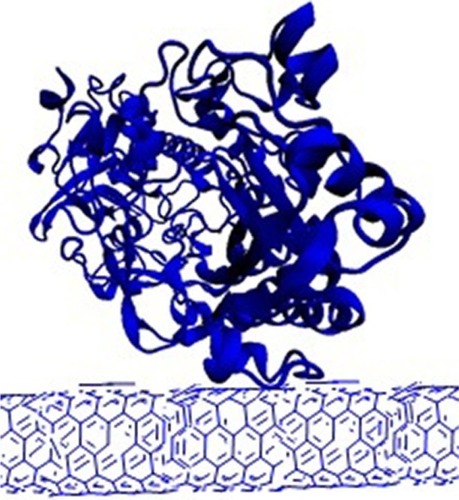
CNTs are used as drug carriers which enables their continuous and constant dosing in pathological cells (). In addition, they may contain antibodies or enzymes specifically targeting their action.Citation199 For example, polyhedral nanotubes containing cisplatin show anticancer activity by inhibition of tumor cell growth.Citation200 Similar results were obtained by combining doxorubicin with CNTs in the treatment of breast cancerCitation201 or by combining carboplatin with CNTs in the treatment of bladder cancer.Citation202 CNTs are characterized by high semiconductivity, strong fluorescence and Raman scattering. They can also be used as a scaffold for immobilizing biomolecules. Such scaffolds are used in biological diagnostics as nanosensors in protein microarrays with a detection sensitivity up to 1 fmol/L.Citation203 The use of the biosensor may be based on the sensing of changes in glucose concentration in the intercellular fluid, which, as a result of the increase in the amount of sugar in the body, increases the fluorescence of the infrared nanotubes.Citation204 Fullerenes are used for imaging of tumors during surgical procedures and for observation of lymph nodes located closest to tumor foci. Additionally, radioactive isotopes used in radiotherapy can be introduced into the interior of nanostructures.Citation205
Drug delivery nanostructures
“Drug delivery” is an interdisciplinary field of nanobiotechnology that combines engineering, biology, chemistry and medicine. This new trend of science creates the possibility of directing and releasing traditional medicines in a controlled, specific and local way. Thanks to the nanomolecules, the kinetic release of drugs could be regulated, their biodistribution adjusted and the toxic side effects minimized, while the therapeutic effect of a given drug is increased. Because the current drug delivery is characterized by a limited therapeutic due to the inability to achieve high drug concentration in the tissue and and due to the inability to direct the drug to a single cell, that’s why is planned to build a generation of functional biosensors that can be controlled from the outside and that allows for “intelligent” drug delivery. The constructive goal of the nanodrug is to overcome the inherent limitations of biomacromolecular therapeutic agents, including short plasma half-life, poor stability, potential immunogenicity and maximization of therapeutic activity, while minimizing the toxic side effects of the drugs. During working on small objects, a very important feature is observed, that is, increasing the surface to volume ratio. Only this one feature gives the possibility of reducing the drug to the absolute minimum, while maintaining the therapeutic effect of the drug and also minimizing the toxic effects of the drug. The size range in nanometers increases the ability of drug delivery carriers to penetrate the cell membranes, reduces the risk of unwanted hepatic or spleen removal from the body and minimizes their uptake by the reticuloendothelial system.
Thus, the following studiesCitation206–Citation220 set out a new trend in scientific research “drug delivery”, which consists of three thematic components:
the properties of fullerenes described above,Citation8–Citation20,Citation206
docking of drugs and molecular dynamics.Citation215–Citation219
Commercial nanoparticles
Recently, the main goal of research is to create multifunctional nanoparticles and nanomaterials, the properties of which could be controlled in the body through the local environment and external factors such as the external magnetic field. Many pharmaceutical companies have their own research programs aimed at introducing new products based on nanoparticles and nanomaterials and improving current pharmaceuticals. As a result of intense and long analyses, commercial nanosubstances have been introduced, which have been used, among others, in the diagnosis or treatment of neoplastic diseases ().
Table 11 Commercial uses of nanoparticles in medicine
Nanoparticles are a hope in the development of personalized medicine, not only for therapeutic purposes, that is, in real-time cancer treatment at the molecular level, but also for monitoring treatment. For anticancer treatments and molecular MRI, multifunctional and multilayered graphene-encapsulated magnetic nanoparticles were designed and developed at the same time. By assembling polymeric nanogel polyethylenimine (PEI)Citation216 (Acknowledgment section) and antibodies on the nanomolecule,Citation220 it could be possible to identify a new cancer by recognizing integrin receptors on lung cancer tissues ().
Figure 37 Examples of polyethylenimine molecules: linear (A); branched (B) and dendrimer (C).Citation216,Citation217*
Note: Data from Szefler et al.Citation216,Citation217
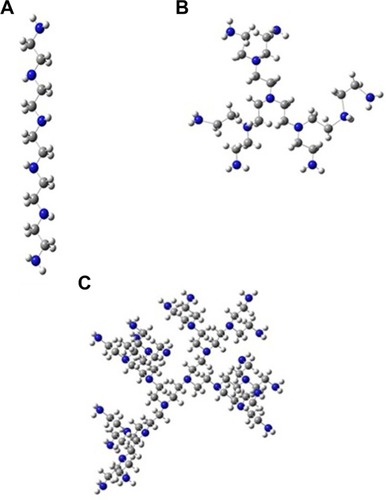
The attached monoclonal antibody was directed to selected receptors of the integrin of tissues and tumor vessels, which was further used in reducing certain signals of transduction due to the selected functions of molecular receptors. To support the anticancer effect, the enzyme (GOx, 3QVR) was released,Citation220 which resulted in the reduction of ATP/ADP synthesis, that, in turn, caused hypoxia of cancerous tissues ().
Figure 38 The protein 3QVR.Citation216*,Citation217*,Citation220
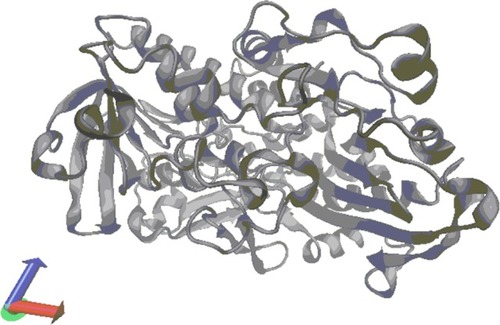
The release of the adsorbed enzyme on nanostructures was fully controlled to promote antitumor activity. Release of the enzyme, resulting in abnormal ATP/ADP synthesis, triggered hypoxic states in lung cancer cells and tissues at the molecular level. In the next step, radiotherapy was applied to target lung cancer. The studies were preceded by quantitative structure-activity relationship studies, microfluidic and genetic/epigenetic approaches to characterize multifunctional and multilayered graphene as a new drug and contrast candidate (drug delivery).
The nature of interactions between PEICitation216,Citation217 (Acknowledgment section) and GOx 3QVRCitation220 enzyme was studied by docking and molecular dynamics procedures. GOx is an enzyme which plays the role of biosensors that can be immobilized onto different nanomaterials and polymers such as PEI.
In order to solve the problem of maintaining the native GOx enzyme (3QVR; and ) activity despite its immobilization on the surface of the PEI polymer, molecular dynamics studies were carried out (). The stability of the complex ligand–enzyme in terms of structure and energy was assessed. Before molecular dynamics, in order to search the best PEI–GOx affinity, docking had been carried out, after which the structure of PEICitation216,Citation217 (Acknowledgment section) was selected (C14N8_07_B22; ). Two places with the best affinity were found after docking (), inside of GOx (LIG1) and on its surface (LIG2).
Figure 39 The ligand PEI_C14N8_07_B22.Citation216*,Citation217*
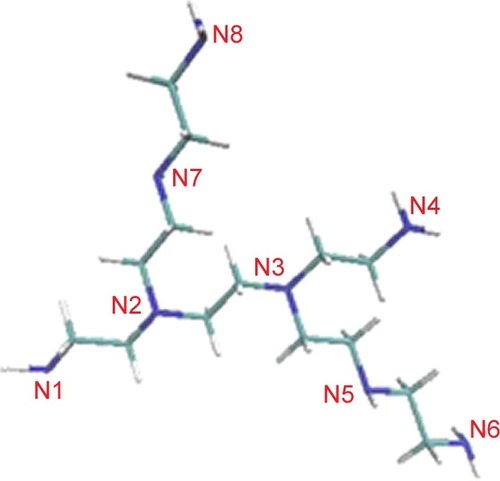
Figure 40 Two sites of the interaction PEI_C14N8_07_B22–3QVR were used during molecular dynamics: inside (LIG1) and on its surface (LIG2).
Note: Data from et alCitation216 and Szefler et al.Citation217
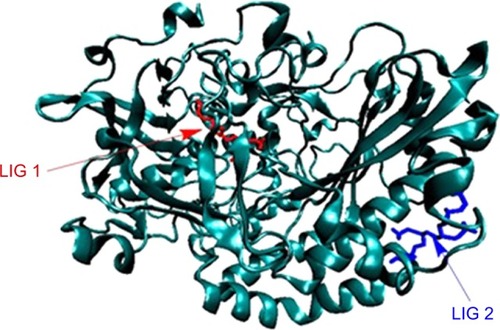
These ligand–enzyme complexes showed differences in their structural and energetic characteristics (see Acknowledgment section).Citation216,Citation217
The RMSD values of systems, their average values and SDs showed that these two systems (LIG1 and LIG2; ) were quite similar. In the first active side, inside of the protein, the stabilization of RMSD ligand appeared with values with small deviations 0.4 Å after 20 ns, while in case of complex formed by ligand on the surface of enzyme, the deviation of RMSD values reached much more higher values ().
Figure 41 RMSD distribution of ligand PEI_C14N8_07_B22 inside of protein and on the protein surface.
Abbreviation: RMSD, root-mean-square deviation.
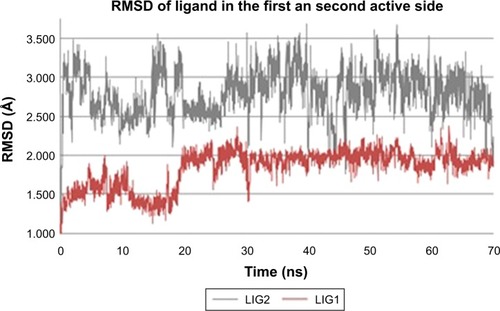
In the first case, small deviation of RMSD values means possibilities of strong and medium hydrogen bond formation, and in the second case, it means possibilities of weak hydrogen bond formation. The mobility of the LIG1, as we can see in , is correlated with changes in the values of dihedral angle (C7–N3–C4–C3), and going further, its structural property decides about hydrogen bond forces.
Figure 42 Distribution of values of the dihedral angle of ligand (C7–N3–C4–C3, LIG1) during MD simulation inside of the protein.
Abbreviation: RMSD, root-mean-square deviation.
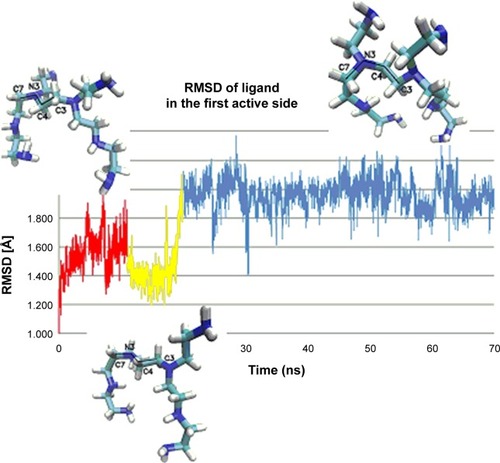
Inside of the protein, the hydrogen bonds (ie, interactions) formed between enzyme and ligand were shorter and stronger, while the lengths of the hydrogen bonds of ligand–enzyme created on the surface of protein were long and weak ().
Figure 43 The length of hydrogen bonds created inside of protein (LIG1) as a function of dihedral angle C7–N3–C4–C3 during MD simulation.
Notes: (A) The length of hydrogen bonds created between oxygen atom (O) of aminoacid Alanine 287 (ALA287) and ligand. (B) The length of hydrogen bonds created between hydrogen atom (H) of aminoacid Leucine 27 (LEU27) and nitrogen atom N1 of ligand. (C) The length of hydrogen bonds created between hydrogen atom (H) of aminoacid Serine 101 (SER101) and nitrogen atom N2 of ligand. (D) The length of hydrogen bonds created between hydrogen atom (H) of aminoacid Serine 94 (SER94) and nitrogen atom N6 of ligand.
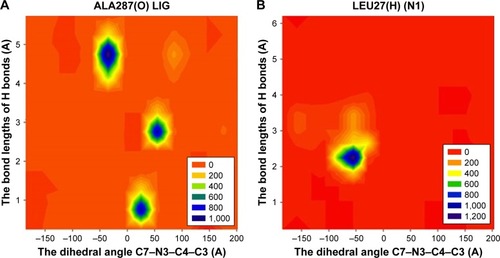
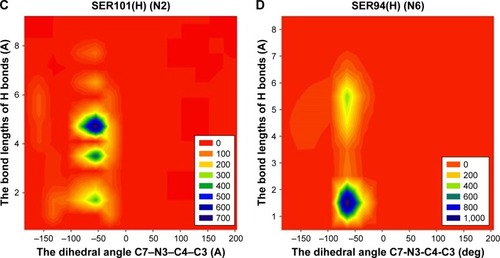
Because one of the problems in creation of intelligent nanoparticle was immobilization of enzyme on the polymer surface, the study of immobilization of GOx on PEI was carried out during molecular dynamics. The analysis of trajectories confirmed energetic and structural stabilization of the formed ligand–enzyme complexes inside of the protein and on its surface.
Conclusion and future perspectives
There are several reasons why nanotechnology is currently taking the lead among the most intensively developing research trends. Nano-matter often exhibits new properties, other than those of the morphology of a continuous solid. Also, new phenomena appear at the nanoscale, which are unknown in the case of microcrystalline objects. For this reason, nanomaterials have already found numerous applications, which have been described in this review. Among intensively developed various branches of nanotechnology, nanomedicine stands out particularly.Citation222 It uses nanoparticles (NCz) and nanomaterials in areas such as nanodiagnostics, nanopharmacology and nanooncology. Nanodiagnostics is mainly based on rapid diagnosis of disease states by using NCz as markers and indicators in diagnostic tests. But one of the best developing areas of nanomedicine is nanopharmacology.Citation221 Thanks to the use of nanoparticles, the pharmacodynamic and pharmacokinetic parameters of the drug are improved, including, among others, bioavailability, time of release of the active substance and prolongation of pharmacological action time. For therapeutic purposes, nanoparticles in the form of liposomes, fullerenes, nanotubes and dendrimers are most commonly used.Citation222 Therefore, nanopharmacology is based on the creation of carrier nanosystems enabling the selective delivery of the drug and its controlled release in pathological cells or tissues. Nanopharmacology also deals with the creation of new nanodrugs and the improvement of existing ones.Citation223 Therefore, the introduction of nanotechnology into medicine and pharmacology opens new possibilities for the development of these disciplines, gives great hope for the creation of drugs where toxicological properties are reduced to a minimum, reduces the doses of medicines, offers targeted treatment, that is, getting the medicines exactly to diseased areas and, at the same time, protecting healthy tissues. It also increases diagnostic possibilities, is an intraoperative assistant for doctors and provides the opportunity to quickly convalesce patients by minimizing the invasiveness of treatments. Such creation of new “nanodrugs” requires a special understanding of the properties of nanoparticles. That is why, in this article, the way of creating a new nanodrug has been described from ab initio calculations by docking and molecular dynamic applications, up to creation of new nanodrug, as a proposition which can be used in the near future in personalized medicine. Nanotechnology is the source of a great revolution in medicine. It gives great hope for better and faster treatment of many diseases, and thus gives hope for a better tomorrow.
Acknowledgments
This review is dedicated to Professor MV Diudea, as a thanks for fruitful cooperation for many years. Some research forming a part of this review was conducted and financed as part of an international project entitled “Self-navigated integrin receptors seeking thermally-smart multifunctional few-layer graphene-encapsulated magnetic nanoparticles for molecular MRI-guided anticancer treatments in real time personalized nanomedicine (acronym GEMNS)”: The European Union’s Seventh Framework Program ERA-NET EuroNanoMed II (European Innovative Research and Technological Development Projects in Nanomedicine). This research was supported by PL-Grid Infrastructure.
Disclosure
The author reports no conflicts of interest in this work.
References
- Robert F. Curl Jr. – BiographicalNobelprize.org Available from: https://www.nobelprize.org/prizes/chemistry/1996/curl/auto-biographyAccessed July 19, 2016
- KrotoHWHeathJRO’BrienSCCurlRFSmalleyREC60: Buck-minster fullereneNature19853186042162163
- KrätschmerWLambLDFostiropoulosKHuffmanDRSolid C60: a new form of carbonNature19903476291354358
- StolnikSIllumLDavisSSLong circulating microparticulate drug carriersAdv Drug Deliv Rev1995162–3195214
- OgawaraK-IYoshidaMFurumotoKUptake by hepatocytes and biliary excretion of intravenously administered polystyrene micro-spheres in ratsJ Drug Target19997321322110680977
- XieQPerez-CorderoEEchegoyenLElectrochemical detection of C606- and C706-: enhanced stability of fullerides in solutionJ Am Chem Soc19921141039783980
- KolmakovAMoskovitsMChemical sensing and catalysis by one-dimensional metal-oxide nanostructuresAnnu Rev Mater Res2004341151180
- SzeflerBDiudeaMVOn molecular dynamics of the diamond D5 seedsStruct Chem2012233717722
- SzeflerBPontaODiudeaMVEnergetics of polybenzene multitoriJ Mol Struct201210228993
- SzeflerBDiudeaMVPolybenzene multitoriCentral Eur J Med20127617791785
- SzeflerBDiudeaMModeling tetrapodal nanotube junctionsComput Methods Sci Technol2012182111115
- DiudeaMVSzeflerBNanotube junctions and the genus of multitoriPhys Chem Chem Phys201214228111811522549433
- SzeflerBSaheliMDiudeaMVSumanene units in P-type surface networksActa Chim Slov20125917718224061188
- DiudeaMVSzeflerBOmega polynomial in polybenzene multi toriIran J Math Sci Inform2012727582
- SzeflerBDiudeaMVPolybenzene revisitedActa Chim Slov20125979580224061361
- SzeflerBOn molecular dynamics of the diamond D5 substructuresDiudeaMVNagyCLCarbon Materials: Chemistry and Physics, 6: Diamond and Related NanostructuresNew York: LondonSpringer Dordrecht, Heidelberg2013119137
- SzeflerBDiudeaMVQuantum-mechanical calculations on molecular substructures involved in nanosystemsMolecules20141910154681550625264833
- DiudeaMVSzeflerBTopology of C20 based spongy nanostructuresComput Methods Sci Technol20152126568
- DiudeaMVSzeflerBNagyCLBendeAExotic allotropes of carbonPutsMVOriOExotic Properties of Carbon Nano-matter New YorkLondonSpringer Dordrecht Heidelberg2015185201
- SzeflerBDiudeaMVCluj and omega polynomials in PAHs and fullerenesRev Curr Org Chem Bentham Publ2015194311330
- DuboisDKadishKMFlanaganSHauflerREChibanteLPFWilsonLJSpectroelectrochemical study of the C60 and C70 fullerenes and their mono-, di-, tri- and tetraanionsJ Am Chem Soc19911131143644366
- PrzygockiWWłochowiczAFulereny i nanorurki [Fullerenes and nanotubes. Properties and application]Wydaw. Nauk.-Techn., Warszawa2001Polish
- JonesDEHThe concept of hollow molecules made from graphite-like sheets was suggested in remarkably inventive piece by David E.H Jones in his column “Ariadne” in the New Scientist magazineNew Scientist196632245
- HeathJRZhangQO’BrienSCCurlRFKrotoHWSmalleyREThe formation of long carbon chain molecules during laser vaporization of graphiteJ Am Chem Soc19871092359363
- StevensonSRiceGGlassTErratum: Small-bandgap endohedral metallofullerenes in high yield and purityNature199940167485557
- FengLSunBHeXGuZIsolation and spectroscopic study of a series of monoterbium endohedral metallofullerenesFuller Nanotub Car N2002104353361
- GuoTSmalleyREScuseriaGEAb initio theoretical predictions of C28, C28H4, 28F4, (Ti@ C28) H4, and M@ C28 (M=Mg, Al, Si, S, Ca, Sc, Ti, Ge, Zr, and Sn)J Chem Phys1993991352359
- TalbergHJThe crystal structure of magnesium p-nitrosophenolate. Hexahydrate. The Influence of hydrogen bonding on conjugation in the p-nitrosophenolateionActa Chem Scand1977A313746
- TalbergHJThe crystal and molecular structure of sodium p-nitroso-phenolate trihydrateActa Chem Scand A19752910
- KatritzkyARKarelsonMWellsAPAromaticity as a quantitative concept. 6. Aromaticity variation with molecular environmentThe Journal of organic chemistry19966151619162311667026
- FeixasFMatitoEPoaterJSolaMElectron sharing indexes at the correlated level. Application to aromaticity calculationsJ Comput Chem2008291543155418270958
- BalabanATIs aromaticity outmoded?Pure Appl Chem198052614091429
- PoaterJGarcıa-CruzIIllasFSoláMDiscrepancy between common local aromaticity measures in a series of carbazole derivativesChem Phys20046314318
- KrygowskiTMCyrañskiMKCzarnockiZHäfelingerGKatritzkyARAromaticity: a theoretical concept of immense practical importanceTetrahedron2000561317831796
- MinkinVIGlukhovtsevMNSimkinBYAromaticity and Antiaromaticity, Aromaticity and Antiaromaticity Electronic and Structural AspectsNew YorkJohn Wiley & Sons. Inc1994
- MaksićZBVianelloRQuest for the origin of basicity: initial vs final state effect in neutral nitrogen basesJ Phys Chem A20021062419430
- BalabanATOniciuDCKatritzkyARAromaticity as a cornerstone of heterocyclic chemistryChem Rev200410452777281215137807
- PoaterJDuranMSolàMSilviBTheoretical evaluation of electron delocalization in aromatic molecules by means of atoms in molecules (AIM) and electron localization function (ELF) topological approachesChem Rev2005105103911394716218571
- FlygareWHMagnetic interactions in molecules and an analysis of molecular electronic charge distribution from magnetic parametersChem Rev1974746653687
- DaubenHJWilsonJDLaityJLDiamagnetic susceptibility exaltation as a criterion of aromaticityJ Am Chem Soc1968903811813
- DaubenHJWilsonJDLaityJLDiamagnetic susceptibility exaltation in hydrocarbonsJ Am Chem Soc196991819911998
- DaubenHJWilsonJDLaityJLNonbenzoid AromaticitySnyderJPElsevier Academic Press INC. New York New York United Kingdom Edition published by ACADEMIC PRESS, INC (LONDON) LTDLondon19712
- KrygowskiTMCyrańskiMCiesielskiAŚwirskaBLeszczyńskiPSeparation of the energetic and geometric contributions to aromaticity. 2. Analysis of the aromatic character of benzene rings in their various topological environments in the benzenoid hydrocarbons. Crystal and molecular structure of coroneneJ Chem Inf Comput Sci199636611351141
- LazzerettiPRing currentsProg Nucl Magn Reson Spectrosc2000361188
- HowardSTKrygowskiTMBenzenoid hydrocarbon aromaticity in terms of charge density descriptorsCan J Chem199775911741181
- KrygowskiTMCyrańskiMSeparation of the energetic and geometric contributions to the aromaticity. Part IV. A general model for the π-electron systemsTetrahedron199652301025510264
- KrygowskiTMCrystallographic studies of inter- and intramolecular interactions reflected in aromatic character of .pi.-electron systemsJ Chem Inf Model19933317078
- CysewskiPSzeflerBSzatyłowiczHKrygowskiTMAn explicit solvent quantum chemistry study on the water environment influence on the interactions of fluoride with phenolNew J Chem2009334831837
- KrygowskiTMCyrańskiMKStructural aspects of aromaticityChem Rev200110151385142011710226
- KatritzkyARKarelsonMSildSKrygowskiTMJugKAromaticity as a quantitative concept. 7. Aromaticity reaffirmed as a multidimensional characteristicJ Org Chem1998631552285231
- PalusiakMKrygowskiTMApplication of AIM parameters at ring critical points for estimation of π-electron delocalization in six-membered aromatic and quasi-aromatic ringsChemistry200713287996800617607686
- CyrańskiMKCiesielskiAKrygowskiTMStępieńDKApplication of graph theory and topological models for the determination of fundamentals of the aromatic character of pi-conjugated hydrocarbonsPure Appl Chem201284410691088
- KadishKMRuoffRSFullerenes: Chemistry, Physics, and TechnologyJohn Wiley & Sons2000
- DiudeaMVNagyCLPeriodic NanostructuresThe NetherlandsSpringer Dordrecht2007
- DiudeaMVNanostructures Novel ArchitectureDiudeaMVNovaYork, NY, USA2005
- DiudeaMVNanomolecules and Nanostructures-Polynomials and Indices. MCM Series 10Kragujevac SerbiaUniversity of Kragujevac Press2010
- AmsharovKYJansenMA C78 fullerene precursor: toward the direct synthesis of higher fullerenesJ Org Chem20087372931293418321126
- AmsharovKJansenMSynthesis of a higher fullerene precursor – an “unrolled” C84 fullereneChem Commun (Camb)20093471926912693
- BarboriniEPiseriPMilaniPBenedekGDucatiCRobertsonJNegatively curved spongy carbonAppl Phys Lett2002811833593361
- TerronesHMackayALFrom C60 to negatively curved graphiteProgress in crystal growth and characterization of materials1997341–42536
- FowlerPWPisanskiTLeapfrog transformations and polyhedra of Clar typeJ Chem Soc Faraday Trans1994901928652871
- SchleyerPMaerkerCDransfeldAJiaoHvan Eikema HommesNJRNucleus-independent chemical shifts: a simple and efficient aromaticity probeJ Am Chem Soc1996118266317631828872872
- PopRMedeleanuMDiudeaMSzeflerBCioslowskiJFullerenes patched by flowersOpen Chem2013114527534
- DiudeaMVDiamond D5, a novel allotrope of carbonStud Univ Babes-Bolyai Chem20105541117
- NagyKNagyCLTasnadiEKatonaGDiudeaMVHyper-diamonds and dodecahedral architectures by tetrapodal carbon nanotube junctionsActa Chim Slov20136011423841325
- DiudeaMVNanostructures, Novel ArchitectureNew York, NYNOVA2005
- DecarliPSJamiesonJCFormation of diamond by explosive shockScience196113334671821182217818997
- AleksenskiiAEBaidakovaMVVul’AYDavydovVYPevtsovaYADiamond–graphite phase transition in ultradisperse-diamond clustersPhys Solid State199739610071015
- ŌsawaERecent progress and perspectives in single-digit nanodiamondDiam Relat Mater2007161220182022
- ŌsawaEMonodisperse single nanodiamond particulatesPure Appl Chem200880713651379
- WilliamsOADouhéretODaenenMHaenenKŌsawaETakahashiMEnhanced diamond nucleation on monodispersed nanocrystalline diamondChem Phys Lett20074454–6255258
- DubrovinskaiaNDubSDubrovinskyLSuperior wear resistance of aggregated diamond nanorodsNano Lett20066482482616608291
- KhachatryanAKAloyanSGMayPWSargsyanRKhachatryanVABaghdasaryanVSGraphite-to-diamond transformation induced by ultrasound cavitationDiam Relat Mater2008176931936
- FrondelCMarvinUBLonsdaleite, a hexagonal polymorph of diamondNature1967214587589
- DiudeaMVBendeAJanežičDOmega polynomial in diamond-like networksFuller Nanotub Car N2010183236243
- HydeSTO’KeeffeMProserpioDMA short history of an elusive yet ubiquitous structure in chemistry, materials, and mathematicsAngew Chem Int Ed Engl200847427996800018767088
- DiudeaMVIlícAAll-pentagonal face multi toriJ Comput Theor Nanosci201184736739
- DiudeaMVPetitjeanMSymmetry in multi toriSymmetry Cult Sci2008194285305
- GundPGundTMHow many rings can share a quaternary atom?J Am Chem Soc19811031544584465
- PaquetteLAVazeuxMThreefold transannular epoxide cyclization. Synthesis of a heterocyclic 17-hexaquinaneTetrahedron Lett1981224291294
- KuckDA facile route to benzoannelated centrotriquinanesAngew Chem Int Ed Engl1984237508509
- KuckDSchusterAPaisdorBGestmannDBenzoannelated centropolyquinanes. Part 21. Centrohexaindane: three complementary syntheses of the highest member of the centropolyindane familyJ Chem Soc Perkin Trans 119956721732
- KuckDThree-dimensional hydrocarbon cores based on multiply fused cyclopentane and indane units: centropolyindanesChem Rev2006106124885492517165679
- SzeflerBDiudeaMVSpongy nanostructuresJ Nanosci Nanotechnol201717132332829620829
- Delgado-FriedrichsOFosterMDO’KeeffeMProserpioDMTreacyMMJRigidYOMFlexible and impossible zeolite and related structuresJ Solid State Chem200517825332554
- BlaseXBenedekGBernasconiMStructural, mechanical and superconducting properties of clathrates. Computer-Based Modeling of Novel Carbon Systems and Their PropertiesBeyond NanotubesColomboLFasolinoA Chap 6Springer2010171206
- O’KeeffeMAdamsGBSankeyOFPredicted new low energy forms of carbonPhys Rev Lett199268152325232810045366
- TerronesHMackayALTriply periodic minimal surfaces decorated with curved graphiteChem Phys Lett199320714550
- BenedekGVahedi-TafreshiHBarboriniEThe structure of negatively curved spongy carbonDiam Relat Mater2003123–7768773
- ValenciaFRomeroAHHernándezETerronesMTerronesHTheoretical characterization of several models of nanoporous carbonNew J Phys2003516123123
- TerronesHTerronesMCurved nanostructured materialsNew J Phys20035126137
- BlaseXBenedekGBernasconiMComputer-Based Modeling of Novel Carbon Systems and Their Properties Beyond NanotubesColomboLFasolino ASpringer2010171206
- DiudeaMVDiamond D5, a novel allotrope of carbonStud Univ Babes-Bolyai Chem20105541117
- DiudeaMVCsLNIlićACarbon Bonding and StructuresPutzMVSpringer2011273289
- DiudeaMVNagyCLCounting polynomials of nanostructuresPeriodic NanostructuresDordrechtSpringer200769114
- DiudeaMVNanostructures: Novel ArchitectureNovaPublishers2005
- IvanovskiiALHyperdiamondsRussian J Inorganic Chem200853812741282
- LenoskyTGonzeXTeterMEnergetics of negatively curved graphitic carbonNature19923556358333335
- MackayALTerronesHDiamond from graphiteNature199135263387621881433
- TerronesHMackayALThe geometry of hypothetical curved graphite structuresThe Fullerenes1993113122
- SchwarzHAÜber Minimalflächen, MonatsberBerlin Akad Berlin1865German
- SchwarzHAGesammelte Matematische Abhandlungen [Collected Matematic Essays]Berlin Springer1890German
- DiudeaMVNanomolecules and Nanostructures – Polynomials and IndicesMCM seriesSerbiaUniv. Kragujevac201010
- YaghiOMO’KeeffeMOckwigNWChaeHKEddaoudiMKimJReticular synthesis and the design of new materialsNature2003423694170571412802325
- DiudeaMVJohnPEGraovacAPrimoracMPisanskiTLeapfrog and related operations on toroidal fullerenesCroat Chem Acta2003762153159
- DiudeaMVCovering forms in nanostructuresForma2004193131163
- ŞtefuMDiudeaMVJohnPEComposite operations on mapsStud Univ Babes-Bolyai Chem2005502165174
- DiudeaMVNanoporous carbon allotropes by septupling map operationsJ Chem Inf Model20054541002100916045294
- DiudeaMVStefuMJohnPEGraovacAGeneralized operations on mapsCroat Chem Acta2006793355362
- StefuMDiudeaMVCVNET SoftwareBabes-Bolyai” UniversityCluj2005
- NagyCSLDiudeaMVNano Studio Software“Babes-Bolyai” UniversityCluj2009
- FrischMJTrucksGWScuseriaGEGaussian 09 Inc.Wallingford CTRevision A.1.2009
- NagyCSLDiudeaMVJSChem software program“Babes-Bolyai” UniversityCluj2005
- Falahati-NezhadFAzariMThe inverse sum indeg index of some nanotubesStud Univ Babes-Bolyai Chem2016611
- SaitoMMiyamotoYTheoretical identification of the smallest fullerene, C 20Physical review letters200187303550311461566
- DiudeaMVHex tori from square toriStud Univ Babes-Bolyai200348310
- ClarEPolycyclic HydrocarbonsLondonAcad Press1964
- JohnPEVizitiuAECigherSDiudeaMVCI index in tubular nanostructuresMATCH Commun Math Comput Chem2007572479484
- HaddonRCRehybridization and .pi.-orbital overlap in nonplanar conjugated organic molecules: .pi.-orbital axis vector (POAV) analysis and three-dimensional Hueckel molecular orbital (3D-HMO) theoryJ Am Chem Soc1987109616761685
- HaddonRCMeasure of nonplanarity in conjugated organic molecules: which structurally characterized molecule displays the highest degree of pyramidalization?J Am Chem Soc1990112933853389
- RandićMAromaticity of polycyclic conjugated hydrocarbonsChem Rev200310393449360612964878
- KrygowskiTMCyrańskiMAromaticity in Heterocyclic CompoundsSpringer2009
- ClarEThe Aromatic SextetNew YorkWiley1972
- BendeADiudeaMVDiamond and Related NanostructuresDiudeaMVNagyCLDordrechtSpringer2013107
- AradiBHourahineBFrauenheimTSelf-interaction and strong correlation in DFTBJ Phys Chem A20071115671567717552499
- ElstnerMPorezagDJungnickelGSelf-consistent-charge density-functional tight-binding method for simulations of complex materials propertiesPhys Rev B1998581172607268
- ElstnerMHobzaPFrauenheimTSuhaiSKaxirasEHydrogen bonding and stacking interactions of nucleic acid base pairs: a density-functional-theory based treatmentJ Chem Phys20011141251495155
- ElstnerMJalkanenKJKnapp-MohammadyMFrauenheimTSuhaiSDFT studies on helix formation in N-acetyl-(L-alanyl)n-N′-methylamide for n=1–20Chem Phys20002561527
- ElstnerMJalkanenKJKnapp-MohammadyMFrauenheimTSuhaiSEnergetics and structure of glycine and alanine based model peptides: approximate SCC-DFTB, AM1 and PM3 methods in comparison with DFT, HF and MP2 calculationsChem Phys20012632–3203219
- AnderssonTNilssonKSundahlMWestmanGWennerstromOC60 embedded in γ-cyclodextrin: a water-soluble fullereneJ Chem Soc Chem Commun19928604606
- WilsonSRLuQQyLElectrospray MS studies of C60 Diels–Alder chemistry: characterization of a C60 Adduct with the Danishefsky DieneTetrahedron Lett1993345080438046
- BrettreichMHirschAA highly water-soluble dendro[60]fullereneTetrahedron Lett1998391827312734
- DuganLLGabrielsenJKYuSPLinT-SChoiDWBuckminster fullerenol free radical scavengers reduce excitotoxic and apoptotic death of cultured cortical neuronsNeurobiol Dis1996321291359173920
- DuganLLTuretskyDMduCCarboxyfullerenes as neuroprotective agentsProc Natl Acad Sci U S A19979417943494399256500
- HuangY-LShenCK-FLuhT-YYangHCHwangKCChouC-KBlockage of apoptotic signaling of transforming growth factor-beta in human hepatoma cells by carboxyfullereneEur J Biochem1998254138439652391
- TokuyamaHYamagoSNakamuraEShirakiTSugiuraYPhoto-induced biochemical activity of fullerene carboxylic acidJ Am Chem Soc19931151779187919
- JensenAWWilsonSRSchusterDIBiological applications of fullerenesBioorg Med Chem1996467677798818226
- IwataNMukaiTYamakoshiYEffect of C60, a fullerene, on the activities of glutathione S-transferase and glutathione-related enzymesFullerene Sci Technol19986213226
- UengTHKangJJWangHWChengYWChiangLYSuppression of microsomal cytochrome P450-dependent monooxygenases and mitochondrial oxidative phosphorylation by fullerenol, a polyhydroxylated fullerene C60Toxicol Lett199793129379381480
- SijbesmaRSrdanovGWudlFSynthesis of a fullerene derivative for the inhibition of HIV enzymesJ Am Chem Soc19931151565106512
- BosiSda RosTCastellanoSBanfiEPratoMAntimycobacterial activity of ionic fullerene derivativesBioorg Med Chem Lett200010101043104510843212
- da RosTPratoMNovelloFMagginiMBanfiEEasy access to water-soluble fullerene derivatives via 1,3-dipolar cycloadditions of azomethine ylides to C60J Org Chem199661259070907211667904
- MashinoTOkudaKHirotaTHirobeMNaganoTMochizukiMInhibition of E coli growth by fullerene derivatives and inhibition mechanismBioorg Med Chem Lett19999202959296210571155
- BiancoAda RosTPratoMTonioloCFullerene-based amino acids and peptidesJ Pept Sci20017420821911354464
- BosiSda RosTSpallutoGPratoMFullerene derivatives: an attractive tool for biological applicationsEur J Med Chem20033811–1291392314642323
- PantarottoDBiancoAPellariniFSolid-phase synthesis of fullerene-peptidesJ Am Chem Soc200212442125431254912381198
- OrmeMWLabrooVMSynthesis of β-estradiol-3-benzoate-17-(succinyl-12A-tetracycline): a potential bone-seeking estrogenBioorg Med Chem Lett199441113751380
- MeyerJLNancollasGHThe influence of multidentate organic phosphonates on the crystal growth of hydroxyapatiteCalcif Tissue Res19731312953034788050
- WillsonTMCharifsonPSBaxterADGeddieNGBone targeted drugs 1. Identification of heterocycles with hydroxyapatite affinityBioorg Med Chem Lett19966910431046
- GonzalezKWilsonLJWuWNancollasGHSynthesis and in vitro characterization of a tissue-selective fullerene: vectoring C60(OH)16AMBP to mineralized boneBioorg Med Chem20021061991199711937359
- ShinoharaHEndohedral metallofullerenesRep Prog Phys2000636843892
- CagleDWKennelSJMirzadehSAlfordJMWilsonLJIn vivo studies of fullerene-based materials using endohedral metallofullerene radiotracersProc Natl Acad Sci U S A19999695182518710220440
- CagleDWThrashTPAlfordMChibanteLPFEhrhardtGJWilsonLJSynthesis, characterization, and neutron activation of holmium metallofullerenesJ Am Chem Soc19961183480438047
- PingZXQing HuaZGao QingLAi BingYInorganic nanoparticles as carriers for efficient cellular deliveryChem Eng Sci20066110271040
- NakamuraEIsobeHTomitaNSawamuraMJinnoSOkayamaHFunctionalized fullerene as an artificial vector for transfectionAngew Chem Int Ed Engl200039234254425729711931
- FoleySCrowleyCSmaihiMCellular localisation of a water-soluble fullerene derivativeBiochem Biophys Res Commun2002294111611912054749
- YamagoSTokuyamaHNakamuraEIn vivo biological behavior of a water-miscible fullerene: 14C labeling, absorption, distribution, excretion and acute toxicityChem Biol1995263853899383440
- McneilSENanotechnology for the biologistJ Leukoc Biol200578358559415923216
- SunCLeeJZhangMMagnetic nanoparticles in MR imaging and drug deliveryAdv Drug Deliv Rev200860111252126518558452
- EchegoyenLEchegoyenLEElectrochemistry of fullerenes and their derivativesAcc Chem Res1998319593601
- WicklineSANeubauerAMWinterPMCaruthersSDLanzaGMMolecular imaging and therapy of atherosclerosis with targeted nanoparticlesJ Magnet Reson Imaging2007254667680
- ItoAShinkaiMHondaHKobayashiTMedical application of functionalized magnetic nanoparticlesJ Biosci Bioeng2005100111116233845
- WetzlerMThomasDAWangESPhase I/II trial of nanomolecular liposomal annamycin in adult patients with relapsed/refractory acute lymphoblastic leukemiaClin Lymphoma Myeloma Leuk201313443043423763920
- LongQXieYHuangYInduction of apoptosis and inhibition of angiogenesis by PEGylated liposomal quercetin in both cisplatin-sensitive and cisplatin-resistant ovarian cancersJ Biomed Nanotechnol20139696597523858960
- ZhouJZhaoW-YMaXThe anticancer efficacy of paclitaxel liposomes modified with mitochondrial targeting conjugate in resistant lung cancerBiomaterials201334143626363823422592
- WangJPengCAAnticancer effectiveness of polymeric drug nanocarriers on colorectal cancer cellsConf Proc IEEE Eng Med Biol Soc2011132493252
- LiYJinMShaoSSmall-sized polymeric micelles incorporating docetaxel suppress distant metastases in the clinically-relevant 4T1 mouse breast cancer modelBMC Cancer201414132924885518
- ChenLShaXJiangXChenYRenQFangXPluronic P105/F127 mixed micelles for the delivery of docetaxel against taxol-resistant non-small cell lung cancer: optimization and in vitro, in vivo evaluationInt J Nanomedicine20138738423319859
- WeissGJChaoJNeidhartJDFirst-in-human Phase 1/2a trial of CRLX101, a cyclodextrin-containing polymer-camptothecin nanopharmaceutical in patients with advanced solid tumor malignanciesInvest New Drugs2013314986100023397498
- YellepeddiVKumarAPalakurthiSBiotinylated poly(amido)amine (PAMAM) dendrimers as carriers for drug delivery to ovarian cancer cells in vitroAnticancer Res20092982933294319661298
- Kukowska-LatalloJFCandidoKACaoZNanoparticle targeting of anticancer drug improves therapeutic response in animal model of human epithelial cancerCancer Res200565125317532415958579
- KolhePMisraEKannanRMKannanSLieh-LaiMDrug complexation, in vitro release and cellular entry of dendrimers and hyper-branched polymersInt J Pharm20032591–214316012787643
- HampelSKunzeDHaaseDCarbon nanotubes filled with a chemotherapeutic agent: a nanocarrier mediates inhibition of tumor cell growthNanomedicine20083217518218373424
- HadjikirovaMTroyanovaPSimeonovaMNanoparticles as drug carrier system of 5-fluorouracil in local treatment of patients with superficial basal cell carcinomaJ BUON200510451717357210
- RingelJErdmannKHampelSCarbon nanofibers and carbon nanotubes sensitize prostate and bladder cancer cells to platinum-based chemotherapeuticsJ Biomed Nanotechnol201410346347724730242
- MuthukumarTPrabhavathiSChamundeeswariMSastryTPBio-modified carbon nanoparticles loaded with methotrexate Possible carrier for anticancer drug deliveryMater Sci Eng C Mater Biol Appl20143636141924433881
- Ali-BoucettaHAl-JamalKTMccarthyDMultiwalled carbon nanotube–doxorubicin supramolecular complexes for cancer therapeuticsChem Commun (Camb)200824459461
- KumarAHuoSZhangXNeuropilin-1-targeted gold nanopar-ticles enhance therapeutic efficacy of platinum(IV) drug for prostate cancer treatmentACS Nano2014854205422024730557
- Sánchez-ParadinasSPérez-AndrésMAlmendral-ParraMJEnhanced cytotoxic activity of bile acid cisplatin derivatives by conjugation with gold nanoparticlesJ Inorg Biochem201413181124239907
- ChenY-HTsaiC-YHuangP-YMethotrexate conjugated to gold nanoparticles inhibits tumor growth in a syngeneic lung tumor modelMol Pharm20074571372217708653
- BenezraMPenate-MedinaOZanzonicoPBMultimodal silica nanoparticles are effective cancer-targeted probes in a model of human melanomaJ Clin Invest201112172768278021670497
- XiDDongSMengXGold nanoparticles as computerized tomography (CT) contrast agentsRSC Adv20122331251512524
- KloepferJAMielkeREWongMSQuantum dots as strain- and metabolism-specific microbiological labelsAppl Environ Microbiol20036974205421312839801
- WangYXSuperparamagnetic iron oxide based MRI contrast agents: current status of clinical applicationQuant Imaging Med Surg20111354023256052
- MillerLWinterGBaurBSynthesis, characterization, and biodistribution of multiple 89Zr-labeled pore-expanded mesoporous silica nanoparticles for PETNanoscale2014694928493524675844
- JainTKRicheyJStrandMLeslie-PeleckyDLFlaskCALabhasetwarVMagnetic nanoparticles with dual functional properties: drug delivery and magnetic resonance imagingBiomaterials200829294012402118649936
- ZerdaALiuZBodapatiSUltrahigh sensitivity carbon nanotube agents for photoacoustic molecular imaging in living miceNano Lett20101062168217220499887
- HirschLRStaffordRJBanksonJANanoshell-mediated near-infrared thermal therapy of tumors under magnetic resonance guidanceProc Natl Acad Sci U S A200310023135491355414597719
- IsmailAFAliMMIsmailLFPhotodynamic therapy mediated antiproliferative activity of some metal-doped ZnO nanoparticles in human liver adenocarcinoma HepG2 cells under UV irradiationJ Photochem Photobiol B2014138C99108
- NurunnabiMKhatunZReeckGRPhotoluminescent graphene nanoparticles for cancer photo-therapy and imagingACS Appl Mater Interfaces2014615124131242125054687
- LiZPanLLZhangFLWangZShenYYZhangZZPreparation and characterization of fullerene (C60) amino acid nanoparticles for liver cancer cell treatmentJ Nanosci Nanotechnol20141464513451824738422
- JohannsenMJordanAScholzREvaluation of magnetic fluid hyperthermia in a standard rat model of prostate cancerJ Endourol200418549550015253831
- JordanAScholzRMaier-HauffKThe effect of thermotherapy using magnetic nanoparticles on rat malignant gliomaJ Neurooncol200678171416314937
- HuangXJainPKEl-SayedIHEl-SayedMAPlasmonic photothermal therapy (PPTT) using gold nanoparticlesLasers Med Sci200823321722817674122
- MackeyMAAliMRAustinLANearRDEl-SayedMAThe most effective gold nanorod size for plasmonic photothermal therapy: theory and in vitro experimentsJ Phys Chem B201411851319132624433049
- MarchesRMikoryakCWangRHPantanoPDraperRKVitettaESThe importance of cellular internalization of antibody-targeted carbon nanotubes in the photothermal ablation of breast cancer cellsNanotechnology201122909510121258147
- WangCHHuangYJChangCWHsuWMPengCAIn vitro photothermal destruction of neuroblastoma cells using carbon nanotubes conjugated with GD2 monoclonal antibodyNanotechnology2009203131510119597244
- OishiMNakaogamiJIshiiTNagasakiYSmart PEGylated gold nanoparticles for the cytoplasmic delivery of siRNA to induce enhanced gene silencingChem Lett200635910461047
- TerranovaMLSessaVRossiMThe world of carbon nanotubes: an overview of CVD growth methodologiesChem Vapor Depos2006126315325
- TripiscianoCKraemerKTaylorABorowiak-PalenESingle-wall carbon nanotubes based anticancer drug delivery systemChem Phys Lett20094784–6200205
- WuWLiRBianXCovalently combining carbon nanotubes with anticancer agent: preparation and antitumor activityACS Nano2009392740275019702292
- Ali-BoucettaHAl-JamalKTMccarthyDPratoMBiancoAKostarelosKMultiwalled carbon nanotube–doxorubicin supramolecular complexes for cancer therapeuticsChem Commun (Camb)20084459461
- LiuZTabakmanSWelsherKDaiHCarbon nanotubes in biology and medicine: in vitro and in vivo detection, imaging and drug deliveryNano Res2009228512020174481
- BaronePWBaikSHellerDAStranoMSNear-infrared optical sensors based on single-walled carbon nanotubesNat Mater200541869215592477
- GrabowskaJFulereny – przyszłość zastosowań w medycynie i farmacjiGaz Farm200863840
- IonutIATiperciucBOnigaOSzeflerBMatiesRCorrelating study on phisycochemical and biological properties of thiosemicarbazone and thiadiazoline derivativesStud Univ Babes-Bolyai Chem2012573109119
- MatiesRSzeflerBIonutITiperciucBQSPR study on the chromatographic behaviour of a set of thiazole derivatives by auto-correlation analysisStud Univ Babes-Bolyai Chem2012574121133
- HarsaTEHarsaAMSzeflerBQSAR of caffeines by similarity cluster predictionCent Eur J Chem2014123365376
- MatiesRSzeflerBDiudeaMVQSAR study on dioxinsStud Univ Babes-Bolyai Chem2015604193200
- HarsaTEHarsaAMDiudeaMVSzeflerBQSAR and docking studies of dopamine derivatives by similarity cluster predictionRev Roum Chim2015607–8727733
- ChenZMaLLiuYChenCApplications of functionalized fullerenes in tumor theranosticsTheranostics20122323825022509193
- SzeflerBHarsaTEHarsaAMQSAR and docking study on Indolizines by similarity clusteringStud Univ Babes-Bolyai Chem2015604201212
- HarsaTEHarsaAMSzeflerBDiudeaMVQSAR study on caffeine derivatives docked on poly(A)RNA polymerase protein cid1Croat Chem Acta20168911724
- LunguCErsaliSSzeflerBPîrvan-MoldovanABasakSDiudeaMVDimensionality of big data sets explored by Cluj descriptorsStud Univ Babes-Bolyai Chem2017623197204
- CzeleńPSzeflerBMolecular dynamics study of ChEMBL474807 inhibition properties against GSK3 and CDK2 enzymesJ Mol Model20152141825605602
- SzeflerBDiudeaMVGrudzińskiIPNature of polyethyleneimine– glucose oxidase interactionsStud Univ Babes-Bolyai Chem201661249260
- SzeflerBDiudeaMVPutzMVGrudzińskiIPMolecular dynamic studies of the complex polyethylenimine and glucose oxidaseInt J Mol Sci20161711pii:E1796
- SzeflerBCzeleńPDiudeaMVUnderstanding the action of indolizines as biologically active moieties: a molecular dynamics studyCurr Comput Aided Drug Des2017131222927719631
- SzeflerBCzeleńPPotential inhibitory effect of indolizine derivatives on the two enzymes: nicotinamide phosphoribosyltransferase and beta lactamase, a molecular dynamics studyJ Mol Model201723720828634829
- RCSB PDB, GOx – molecule of the month, 52006 Available from: https://pdb101.rcsb.org/motm/77Accessed September 21, 2018
- WiśniewskiMRossochackaPWerengowska-CiećwierzKMedyczne aspekty nanostrukturalnych materiałów węglowychInż Ochr Środow [Medical aspects of nanostructured carbon materials]2013162255261 Polish
- Justyna ŻwawiakJKatarzyna Sowa-KasprzakKNanocząstki w roli nośników substancji aktywnych. Nanoparticles as carriers of active substancesFarm Współ20147175182
- Hygeia Public Health2014493449457
- WanFIntroduction to the Calculus of Variations and its ApplicationsRoutledge2017

